
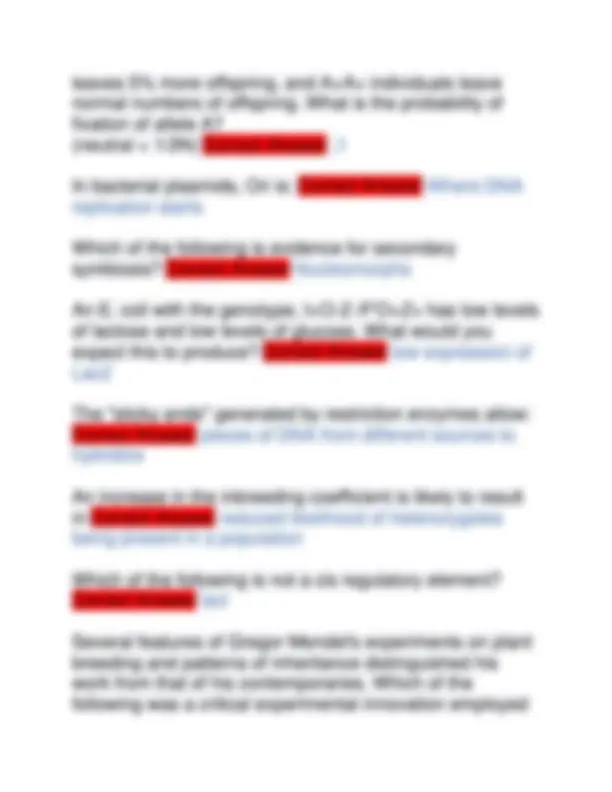
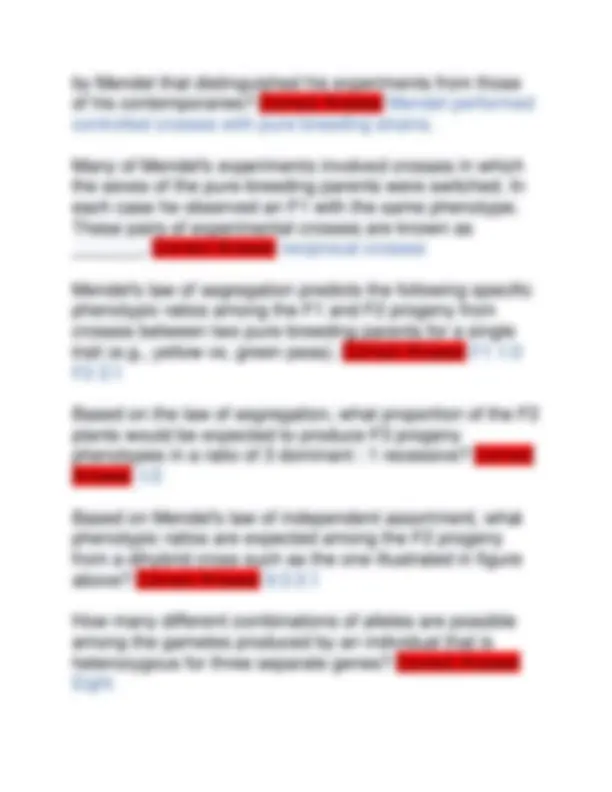
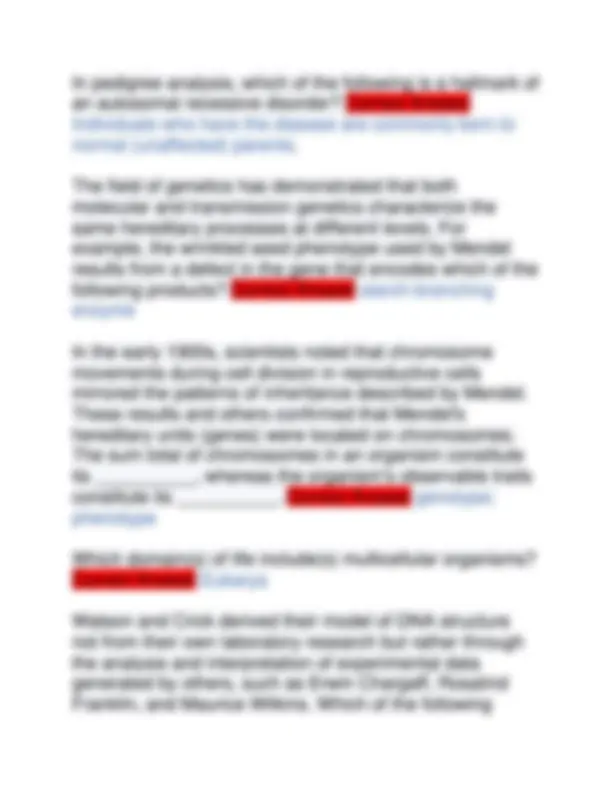
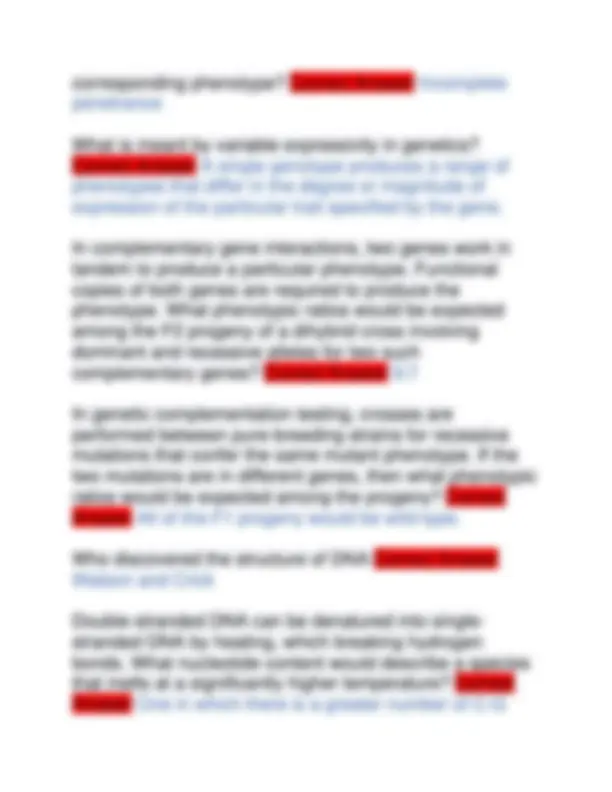
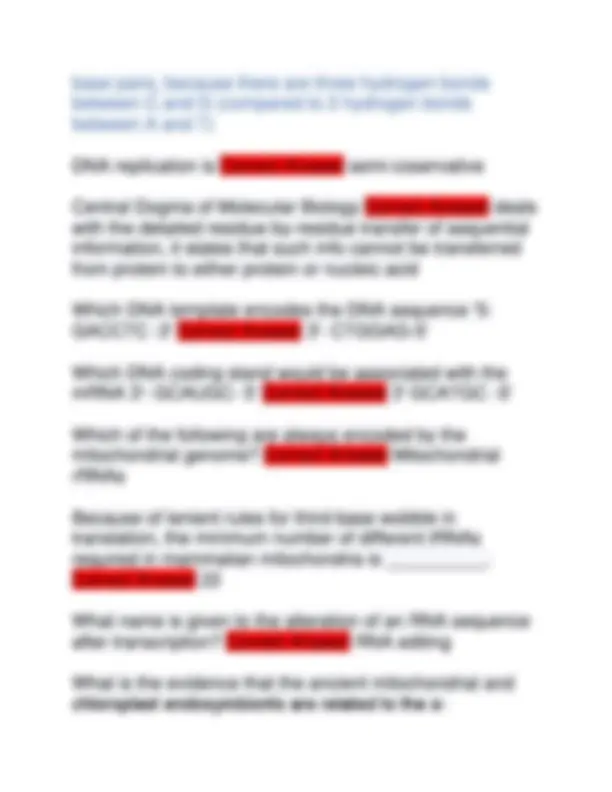
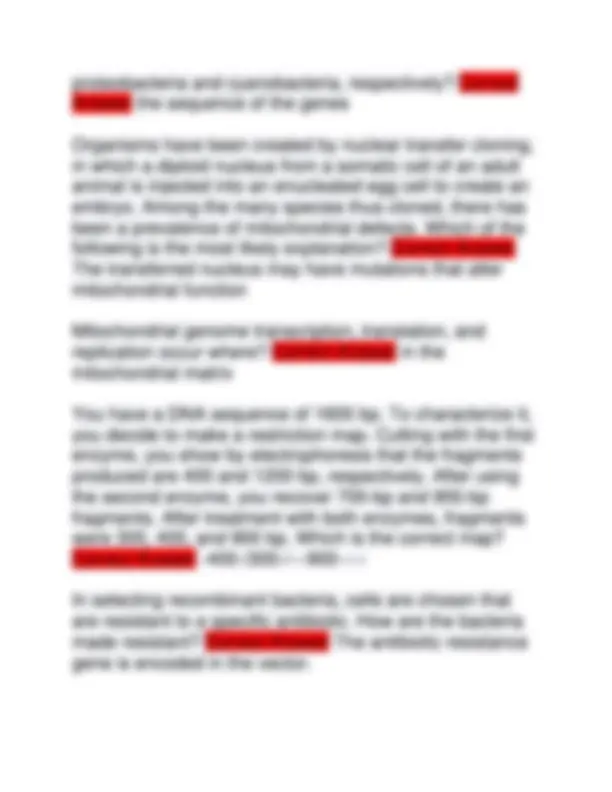
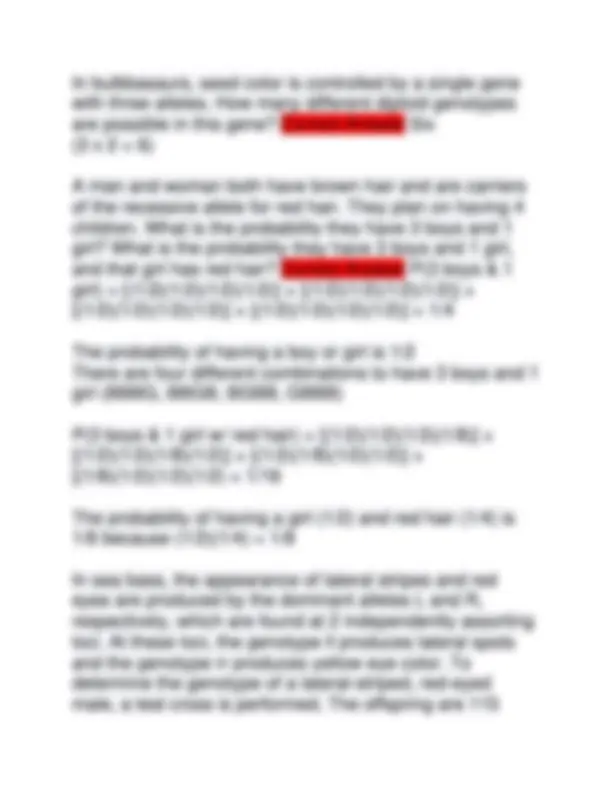
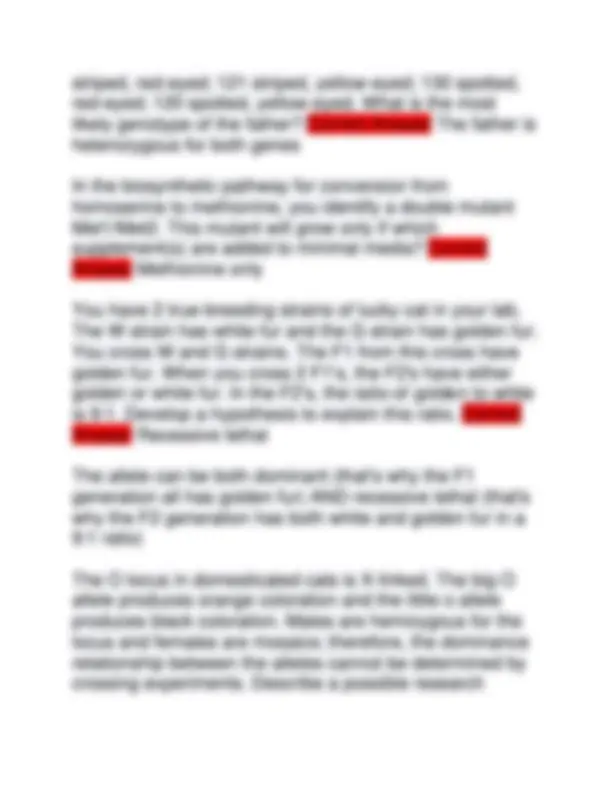
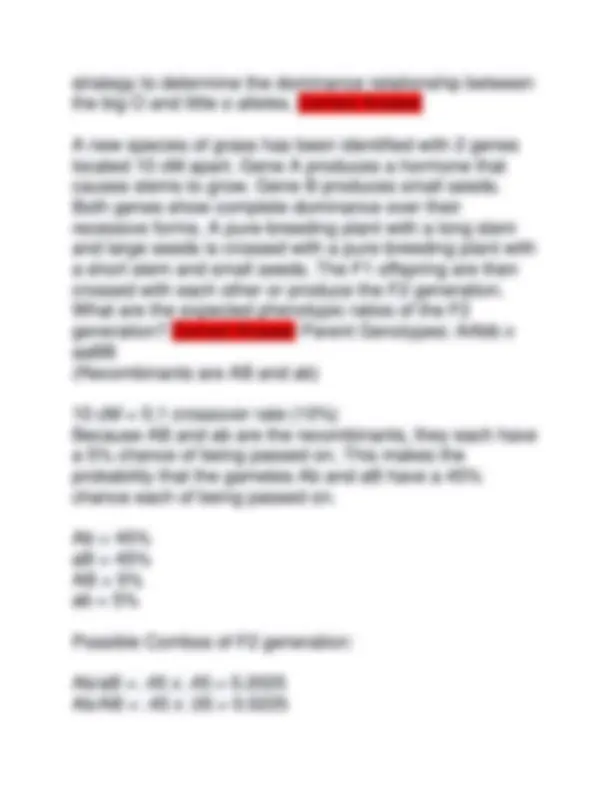
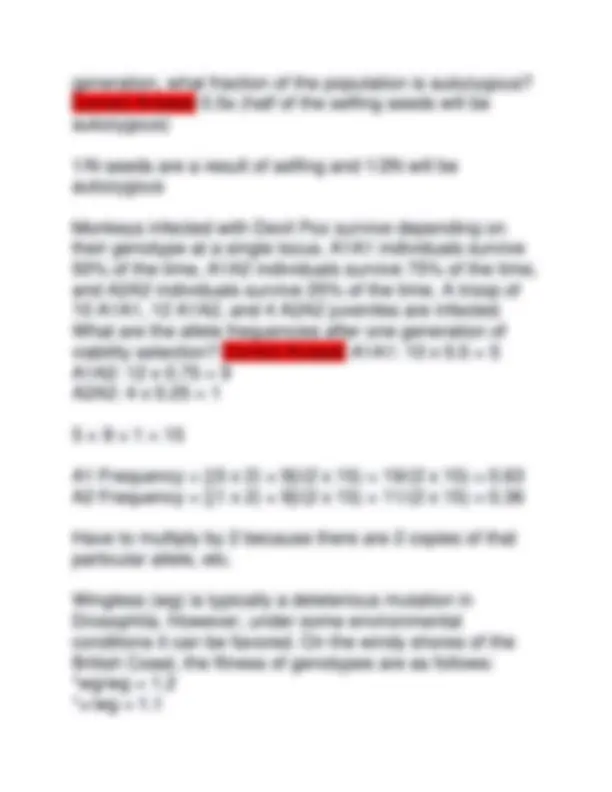
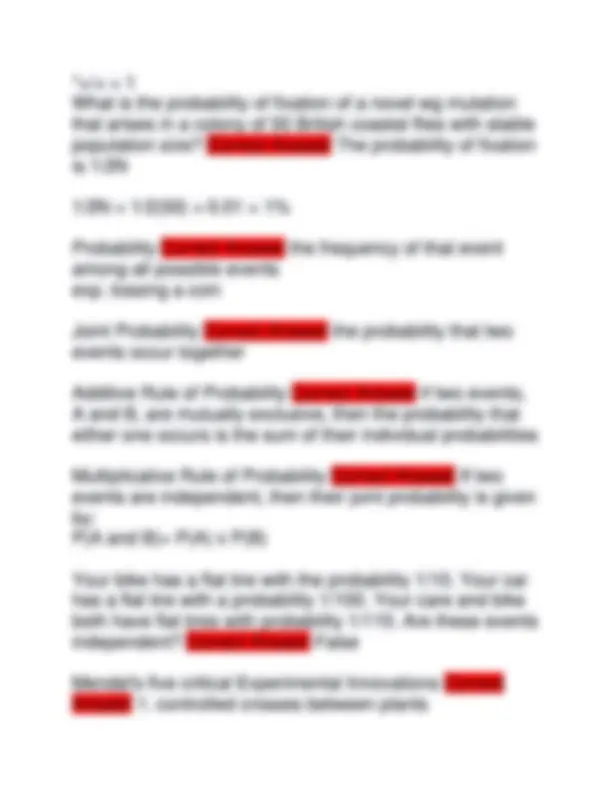
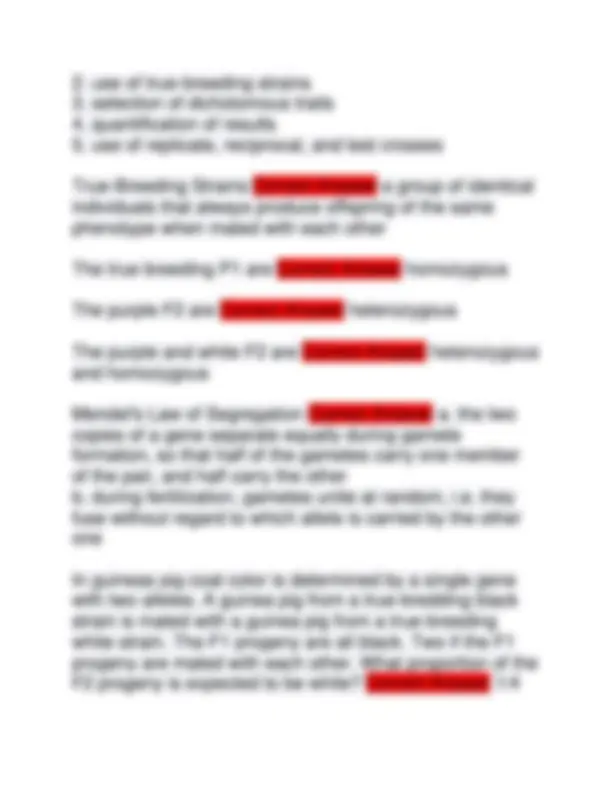
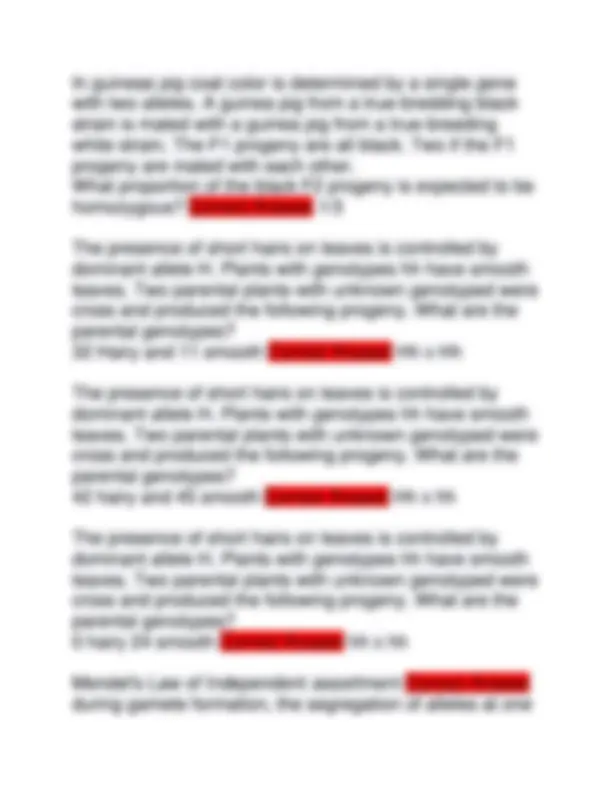
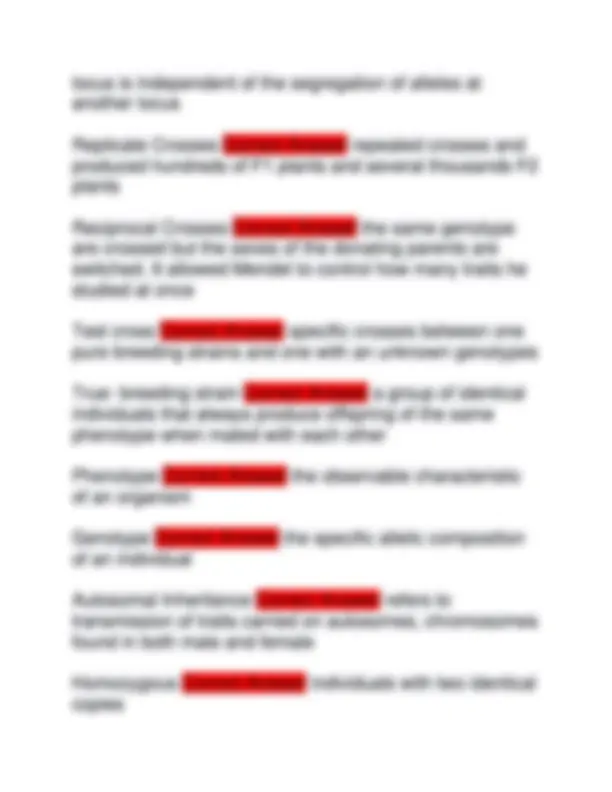
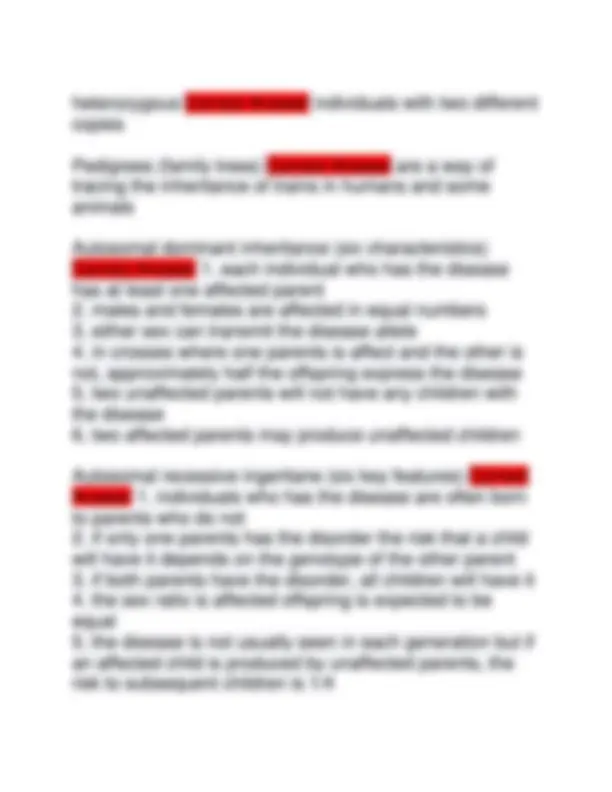
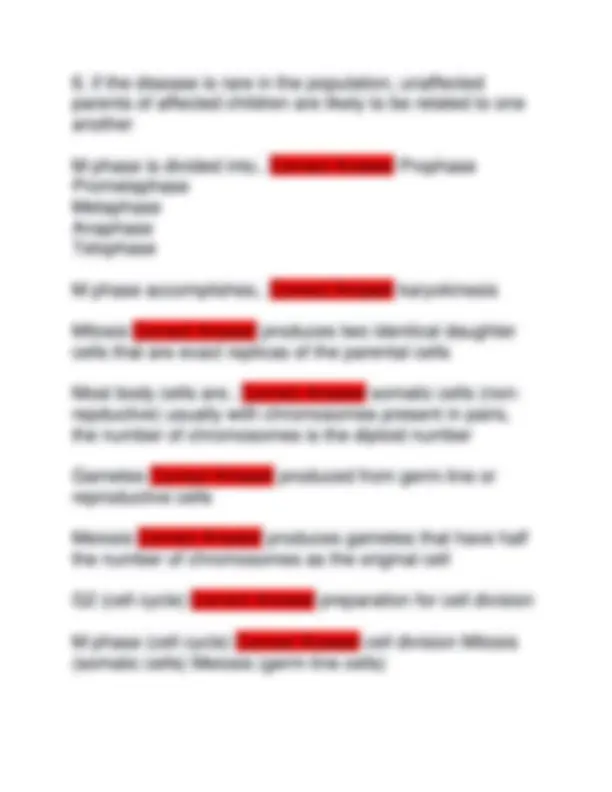
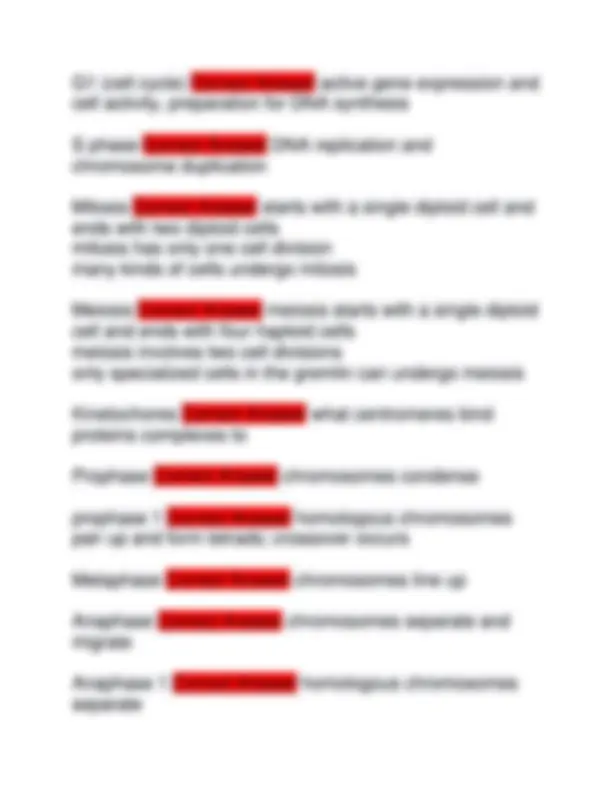
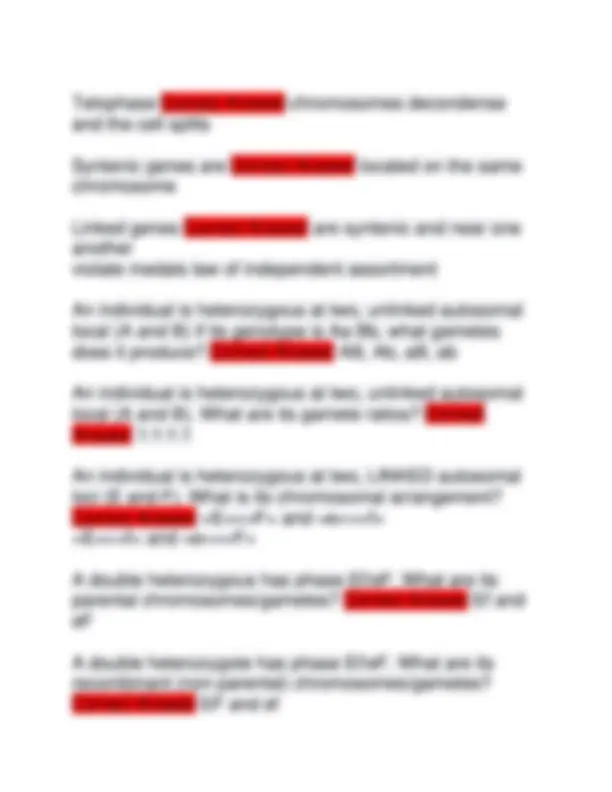
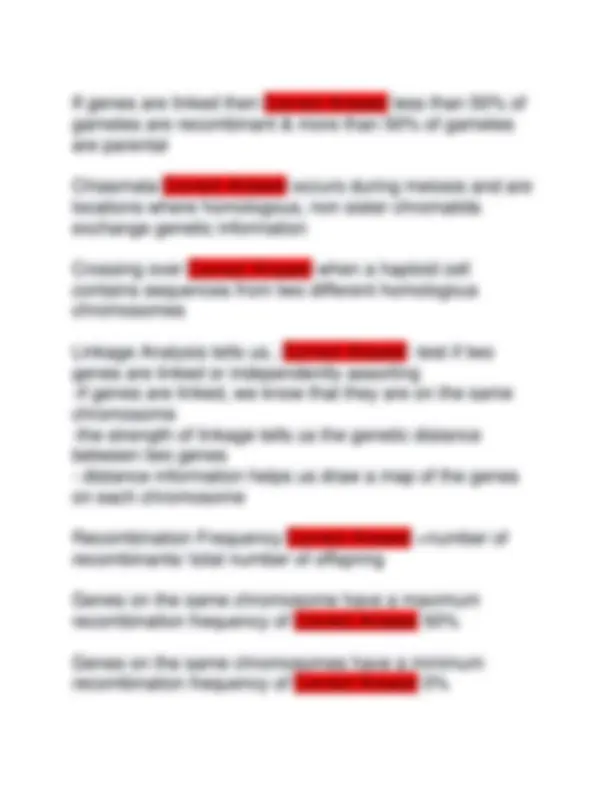
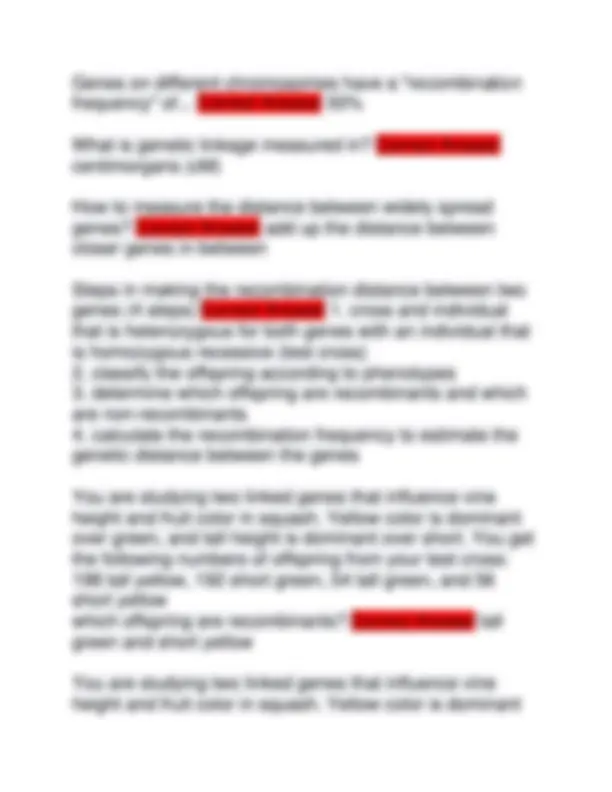
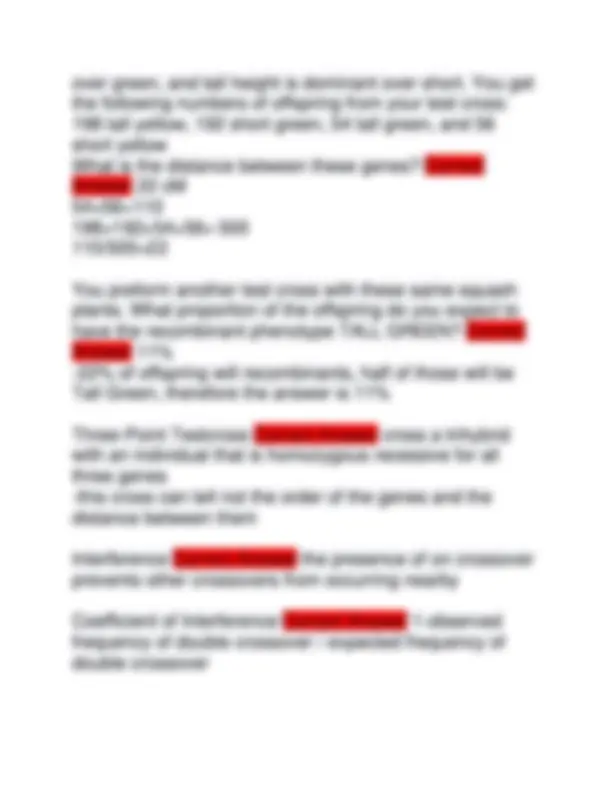
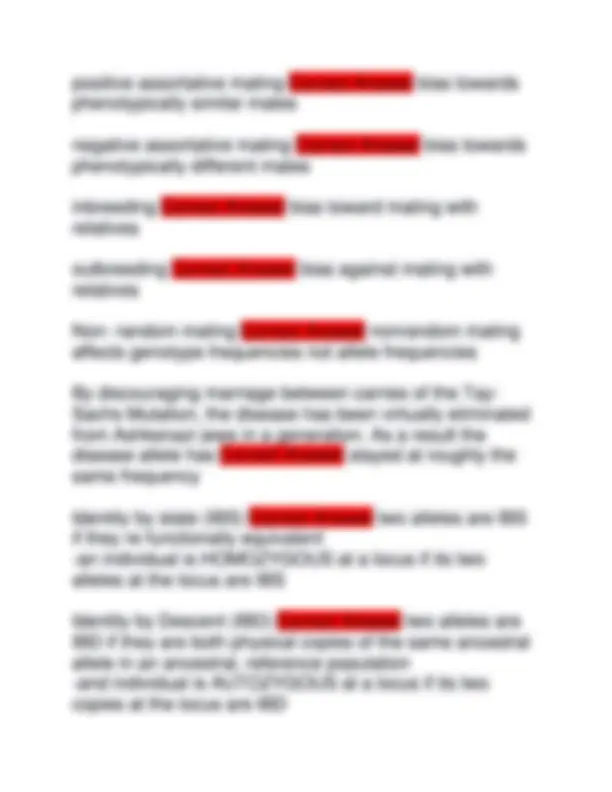
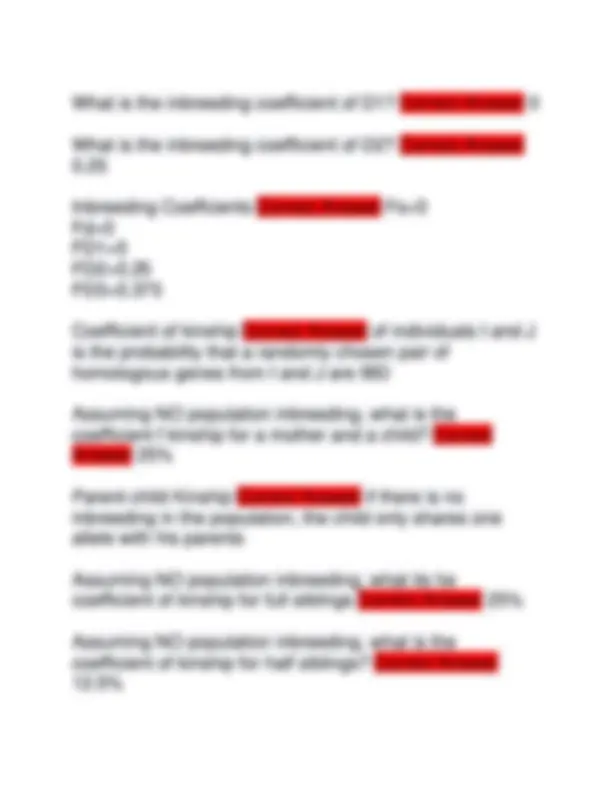
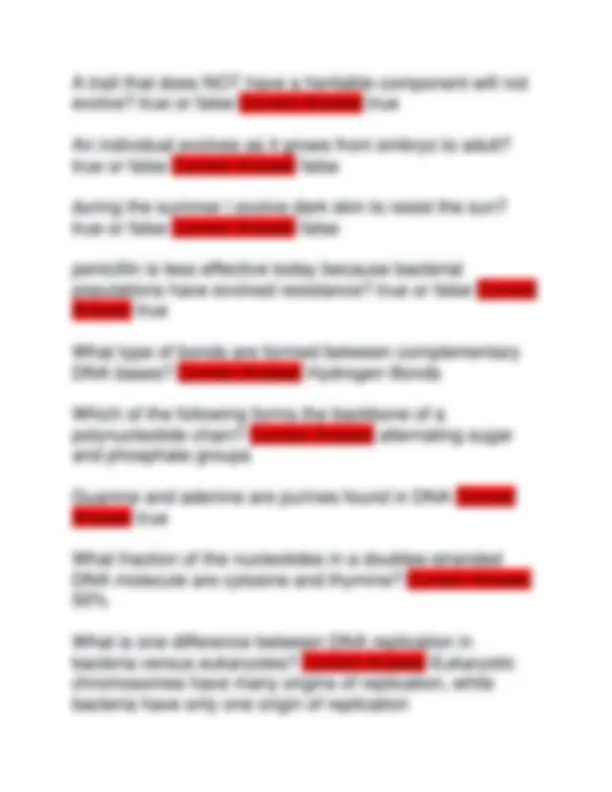
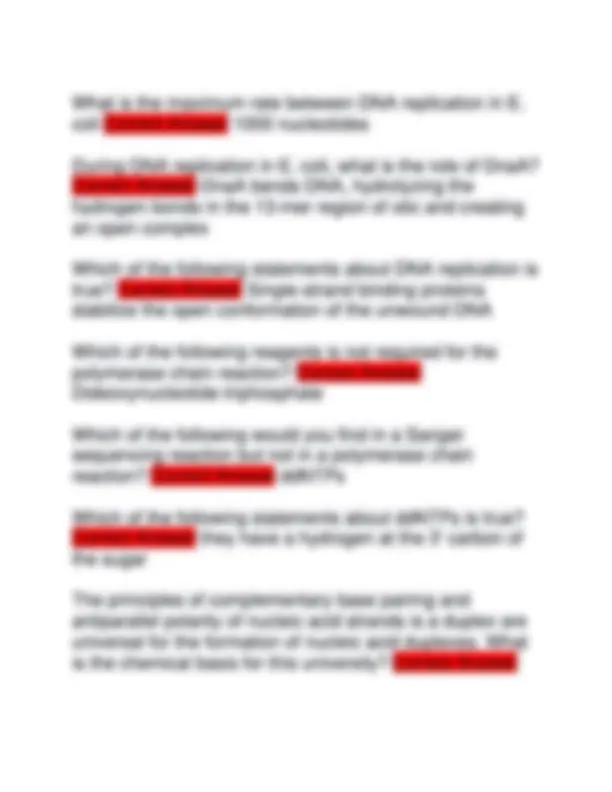
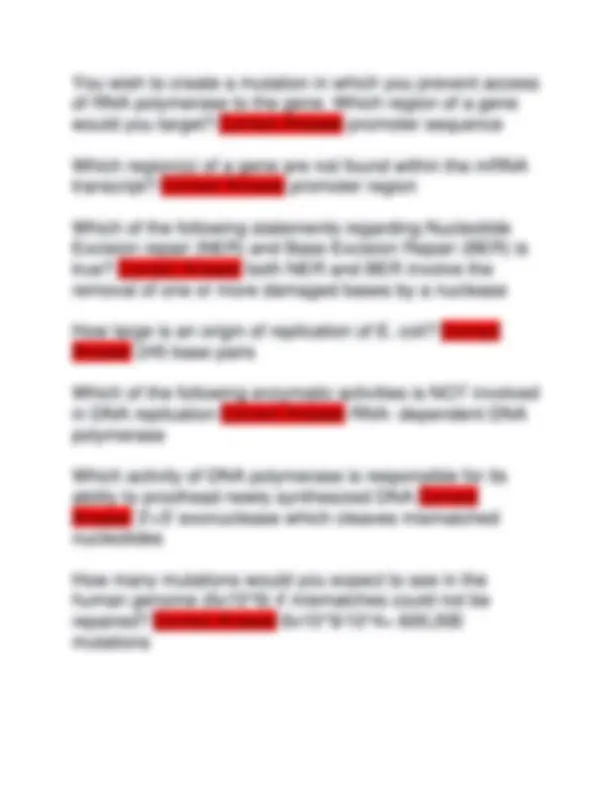
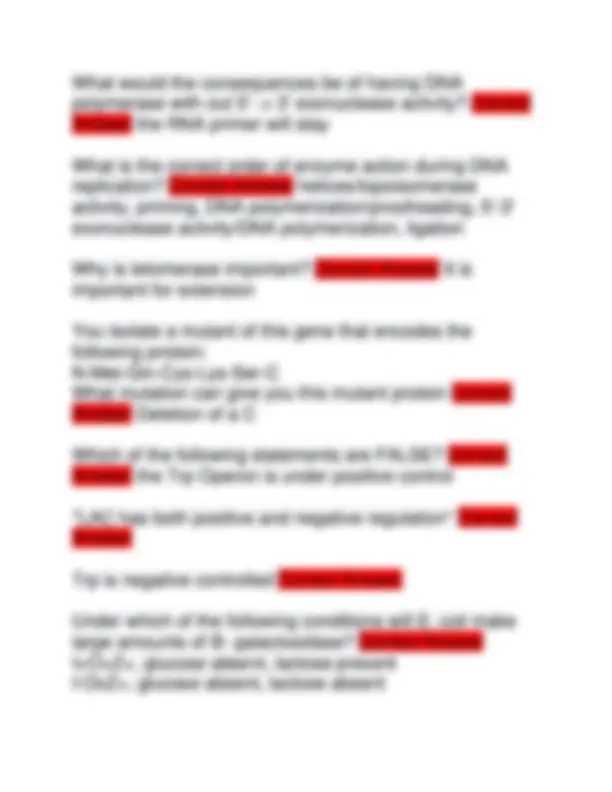
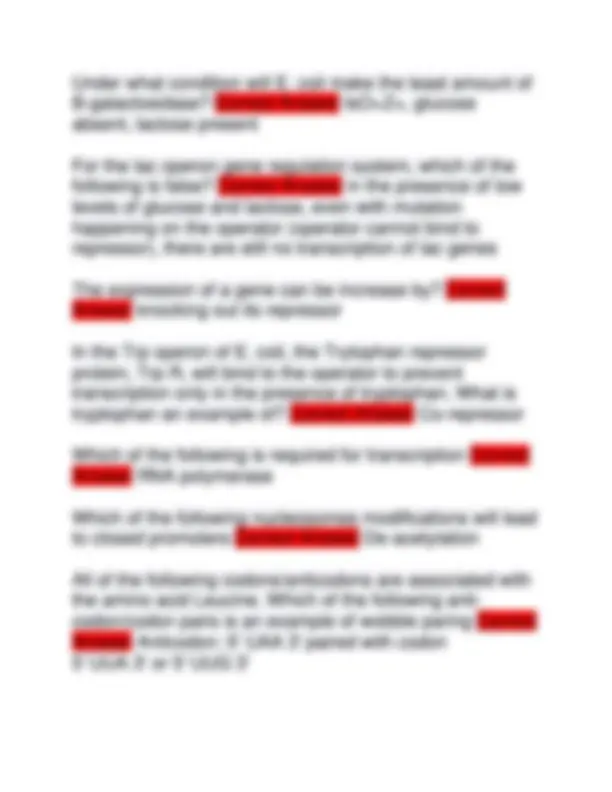

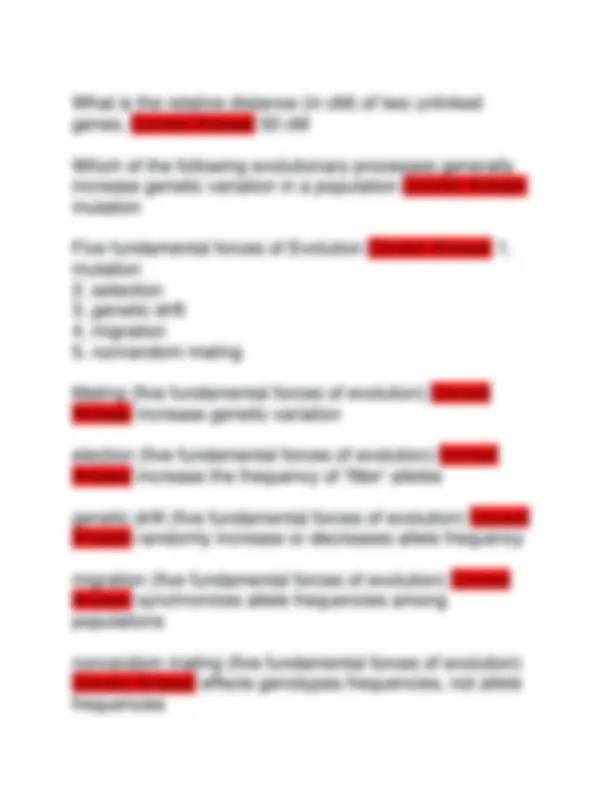
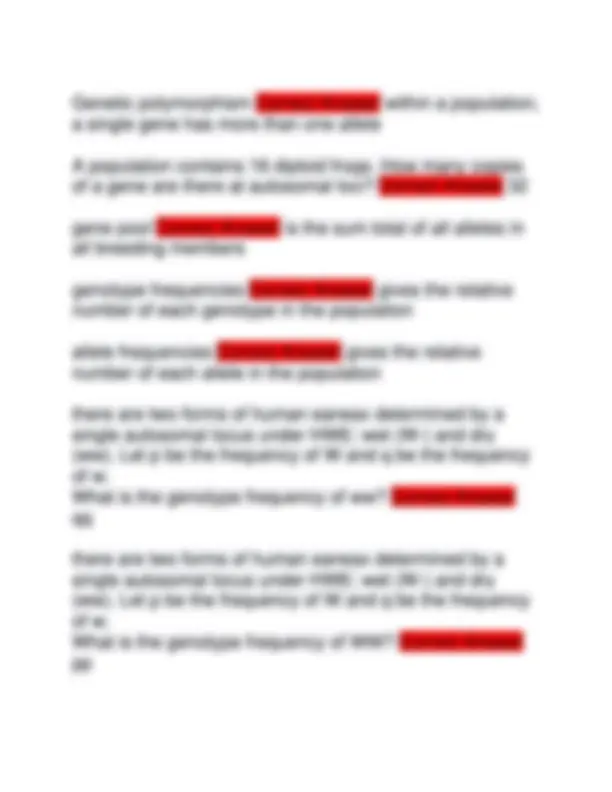
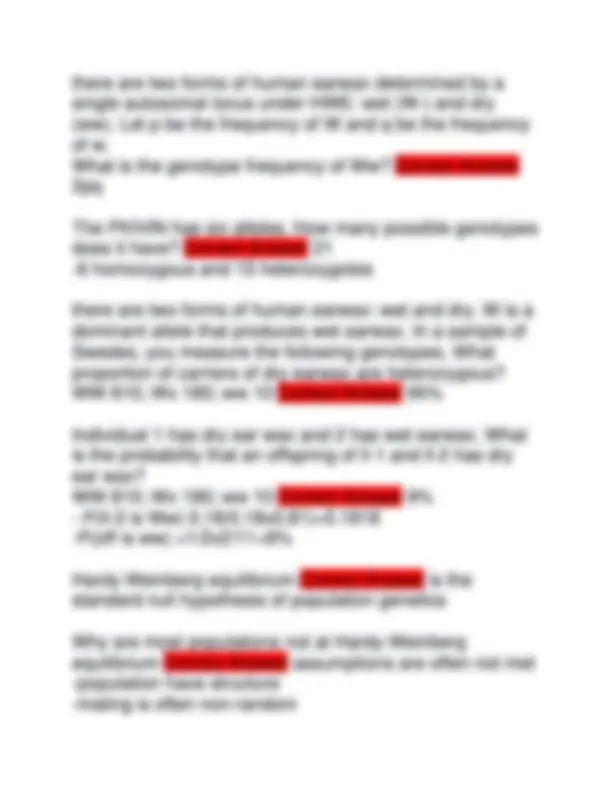
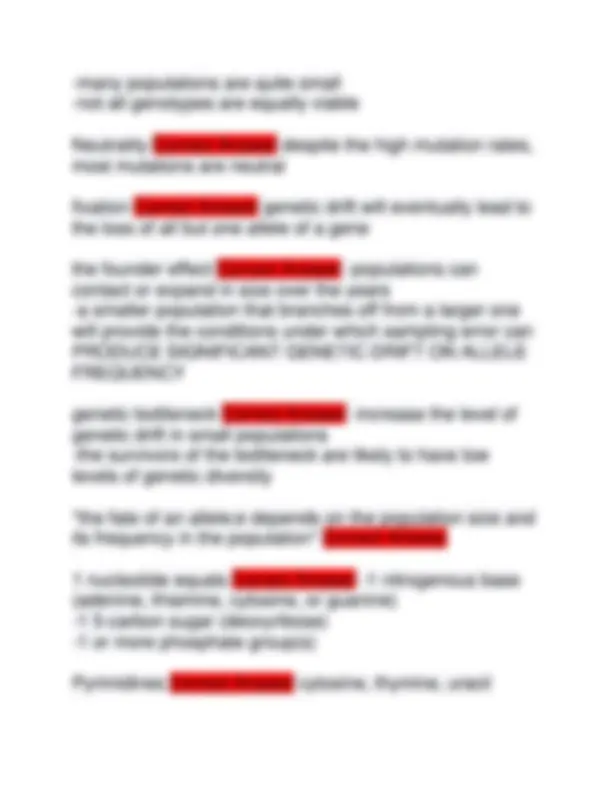
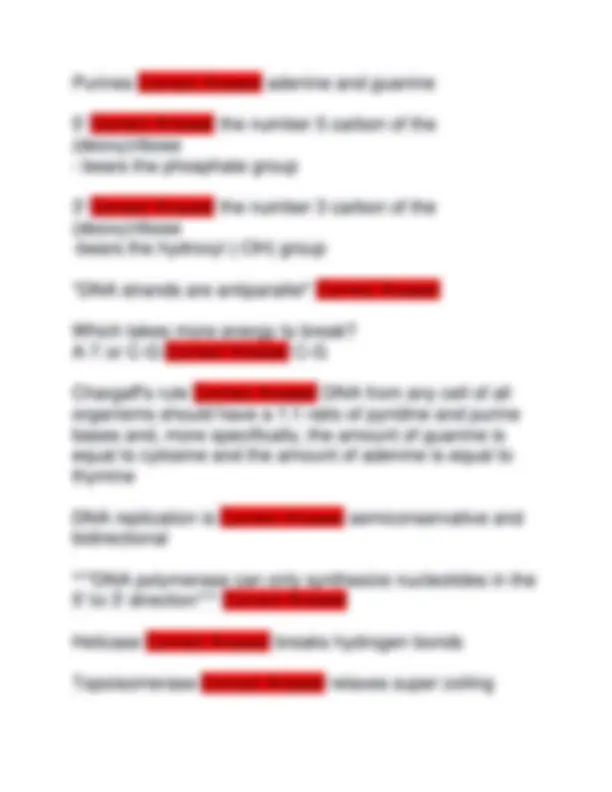
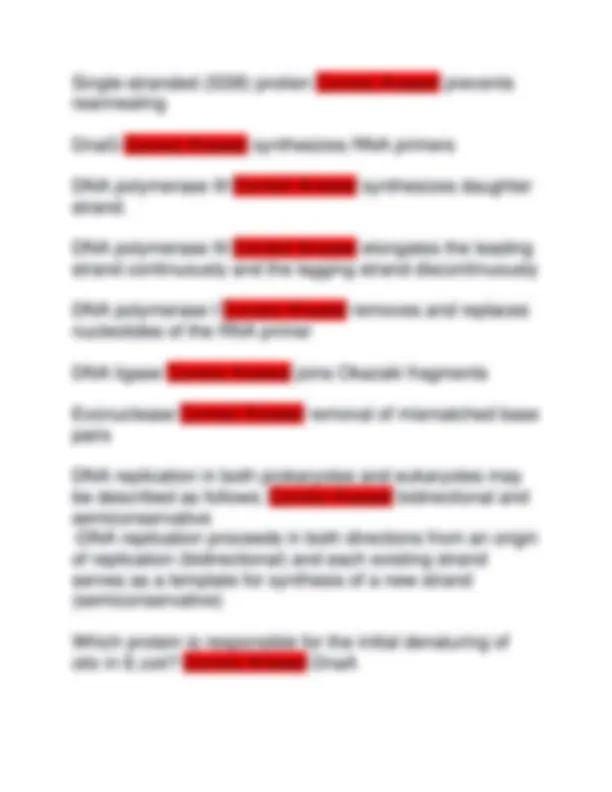
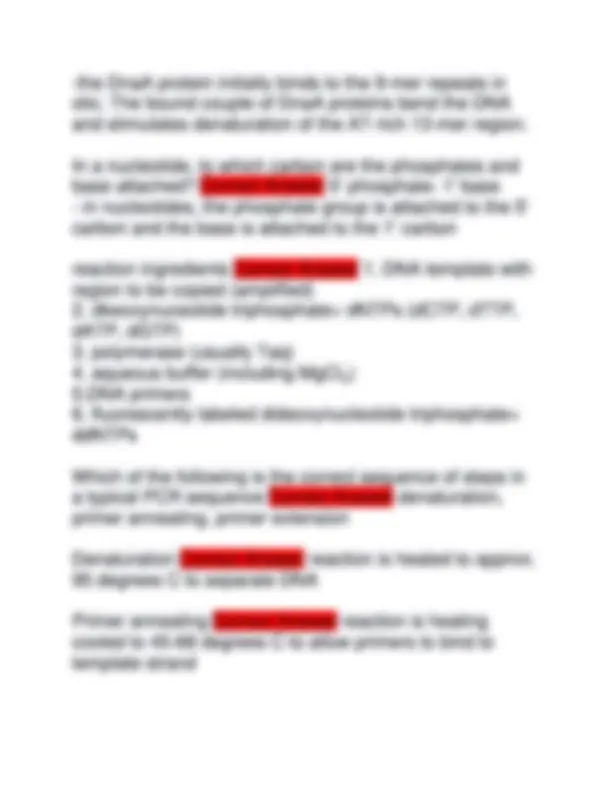
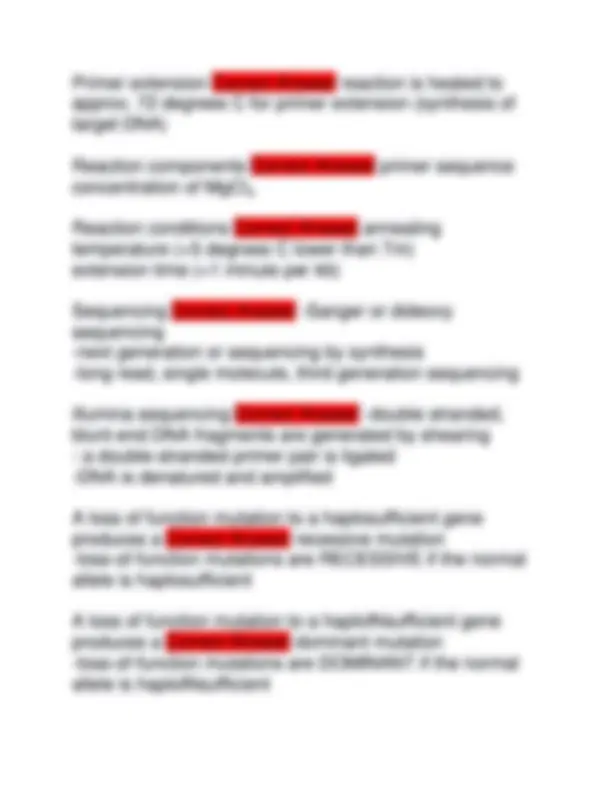
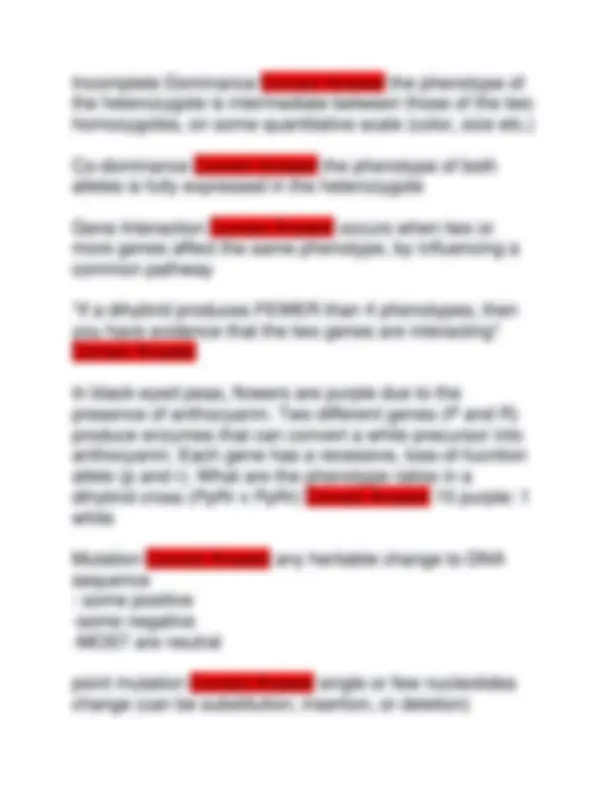
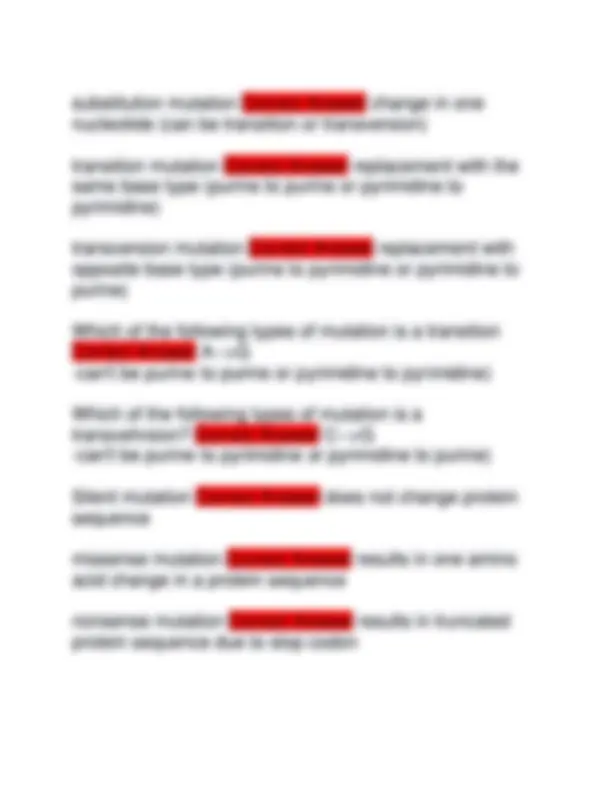
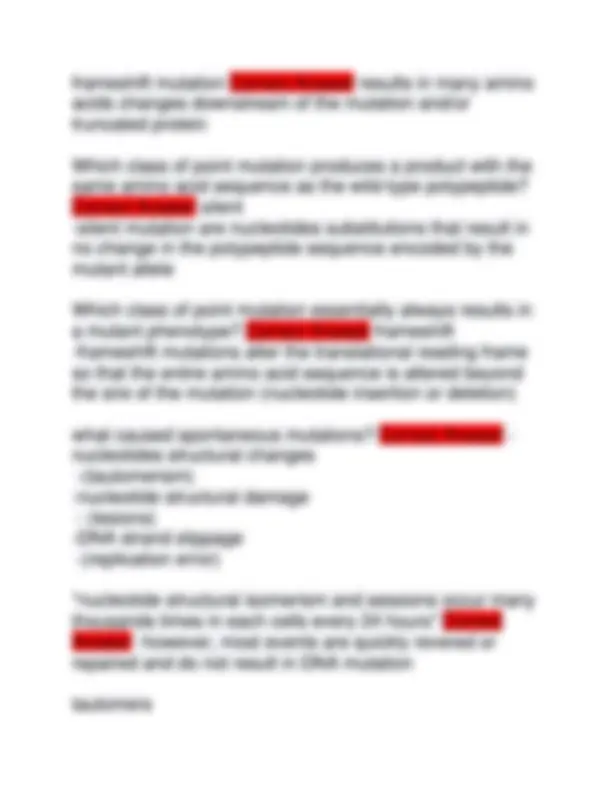
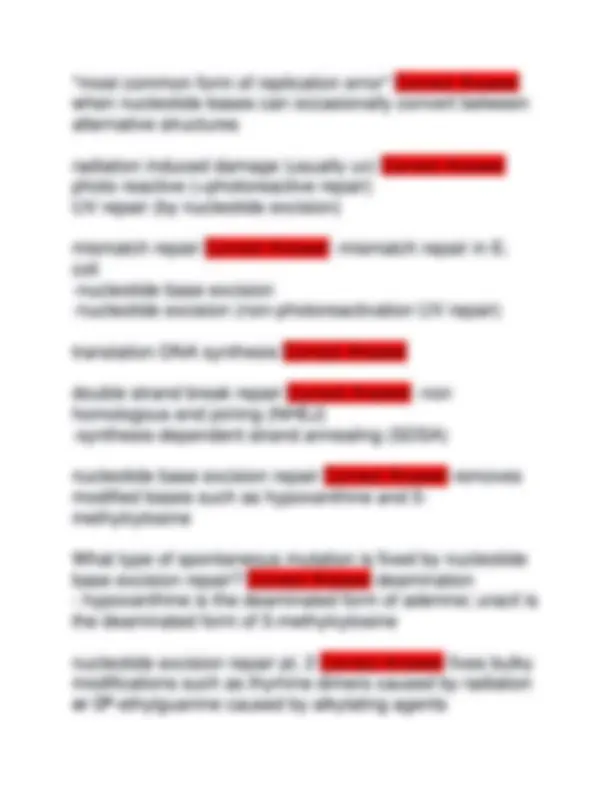
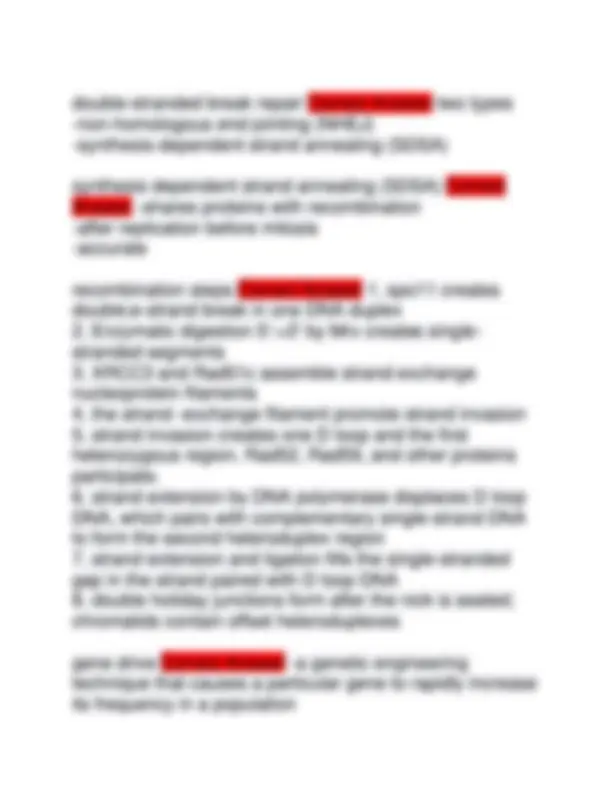
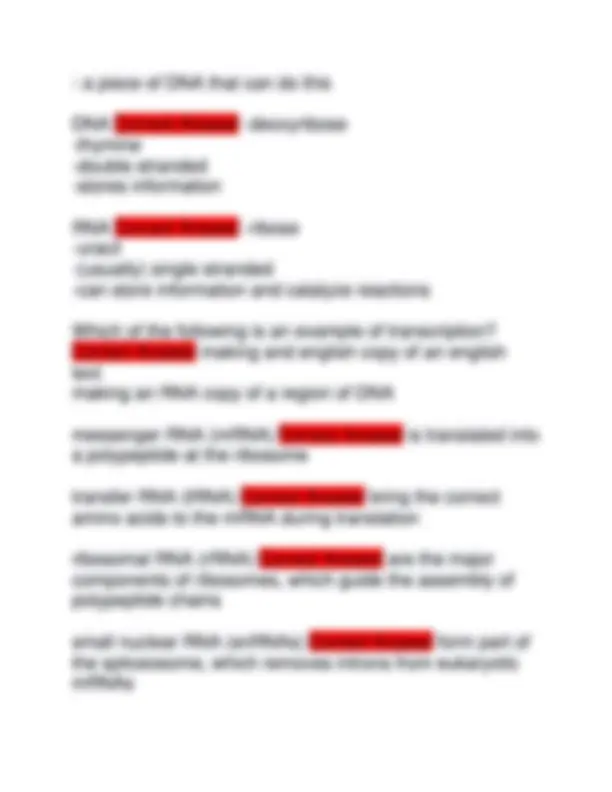
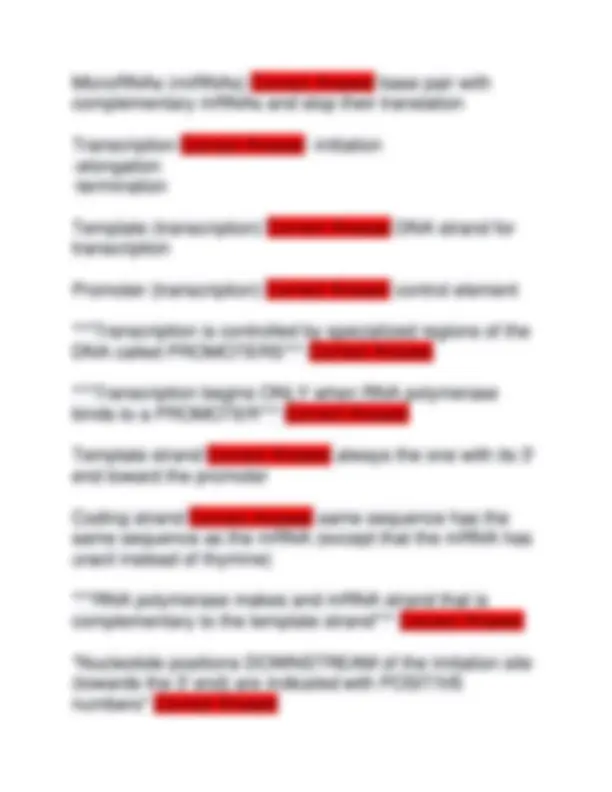
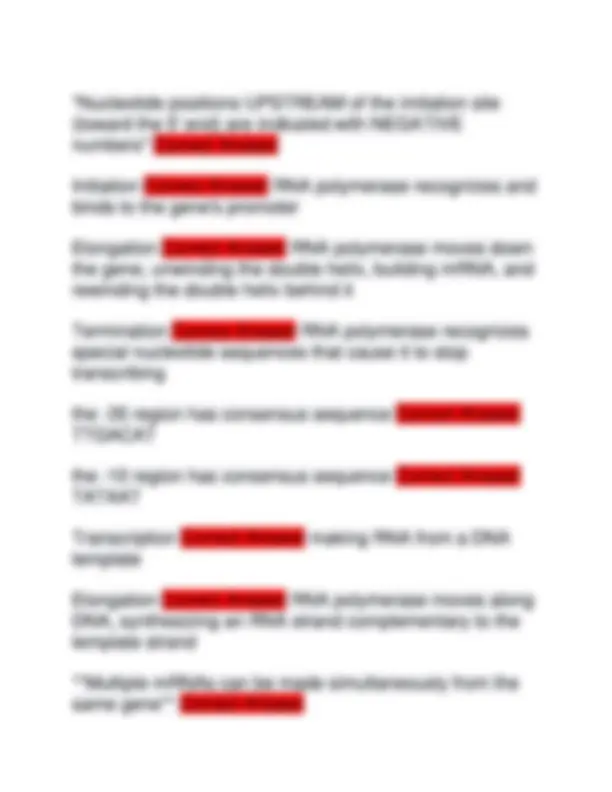
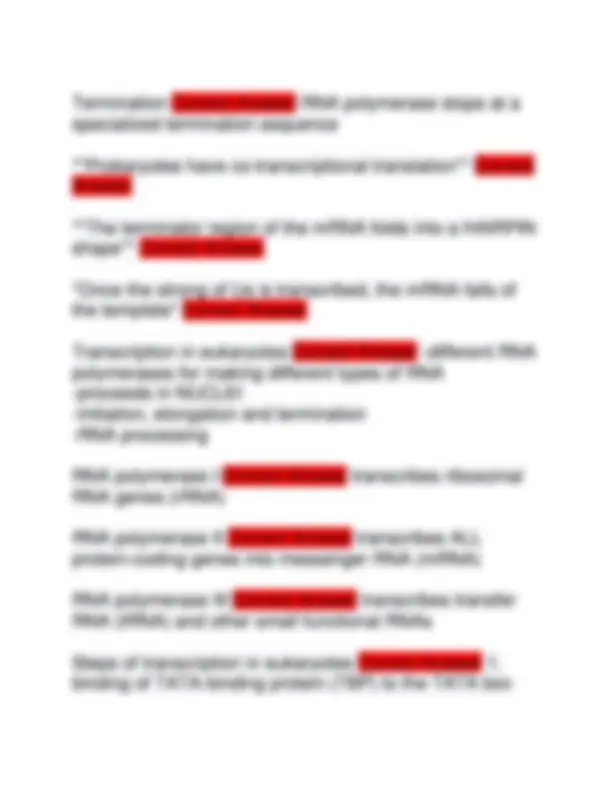
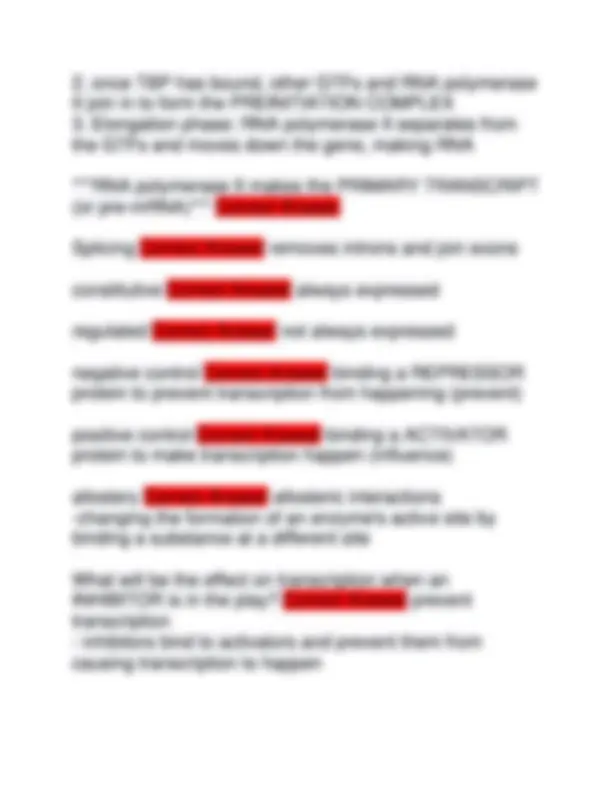
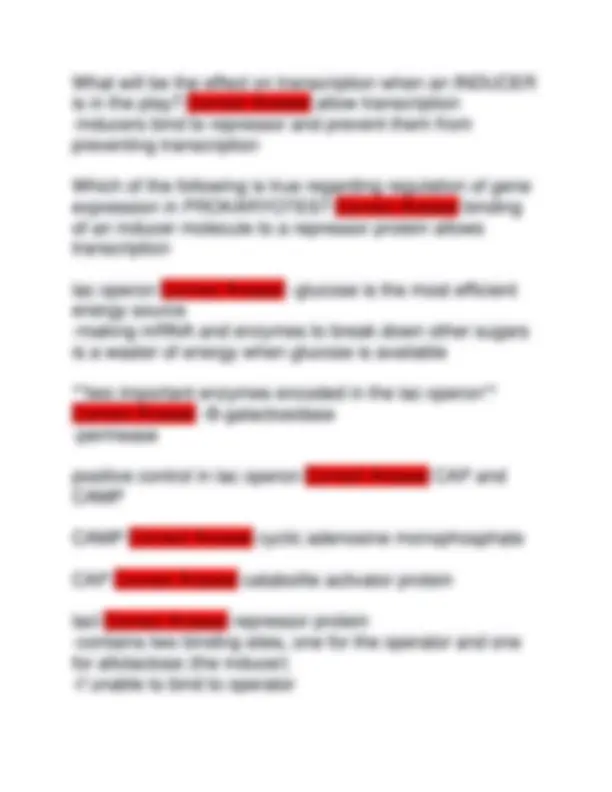
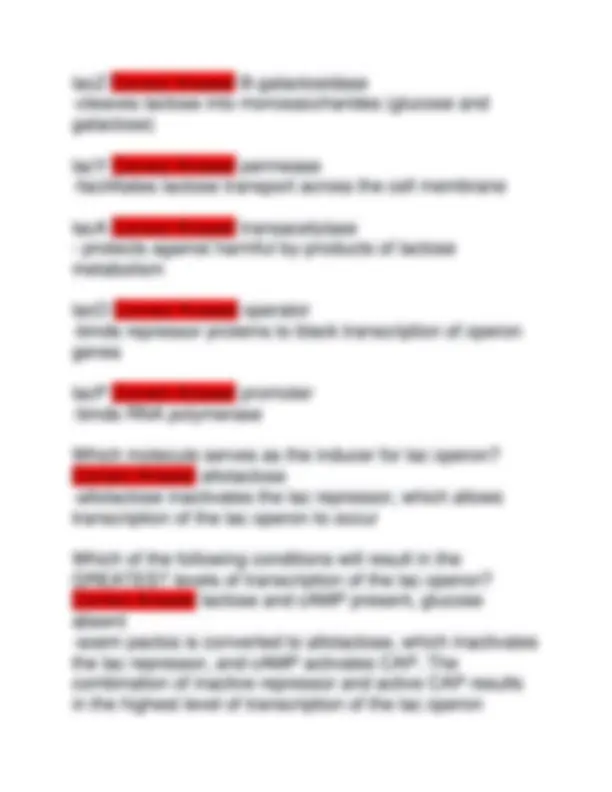
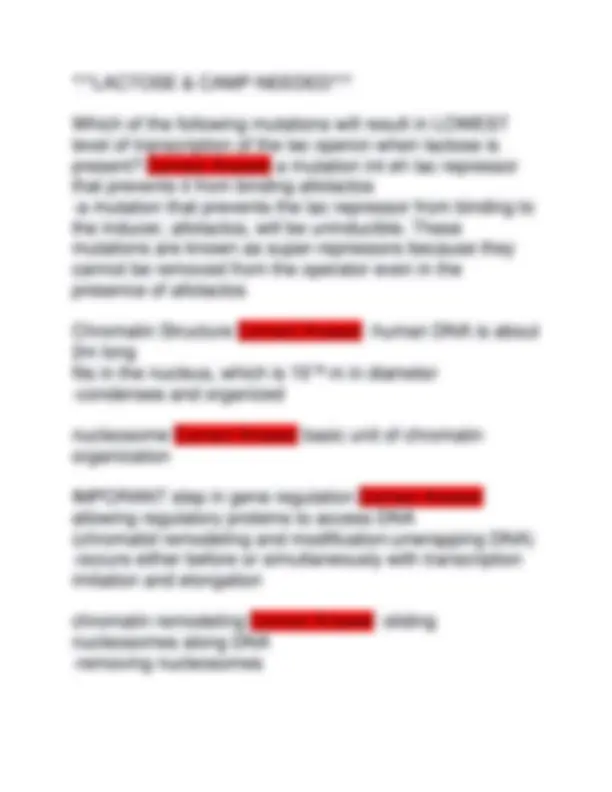
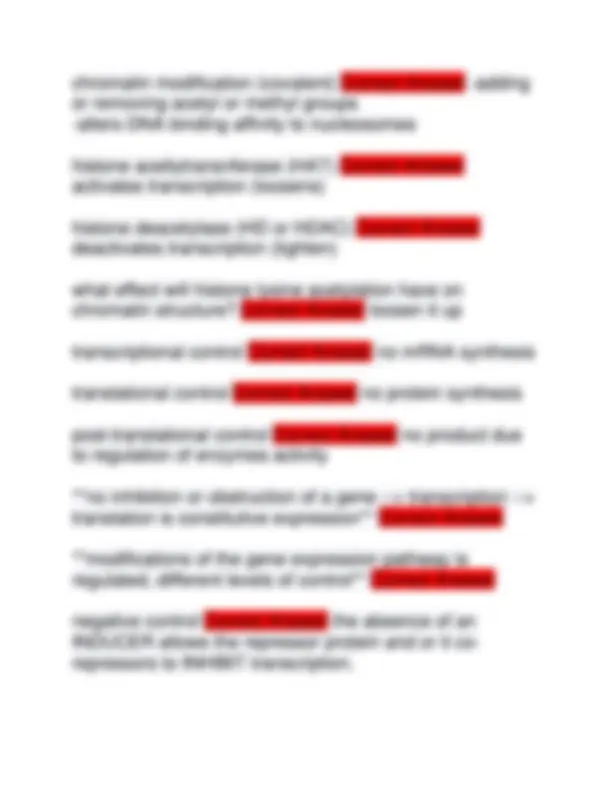
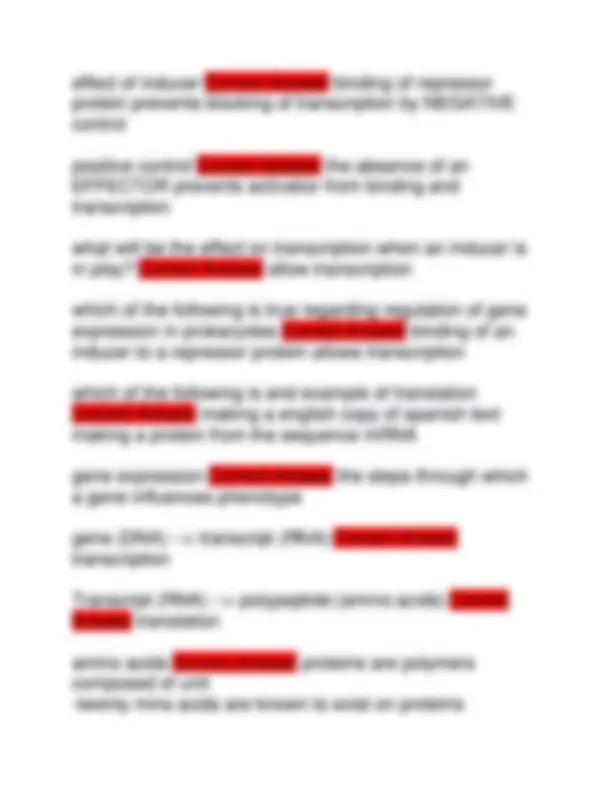
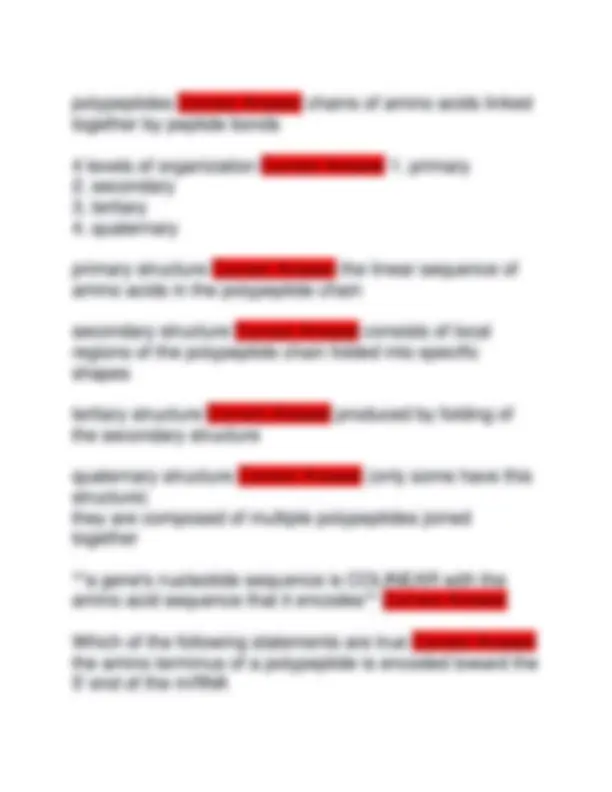
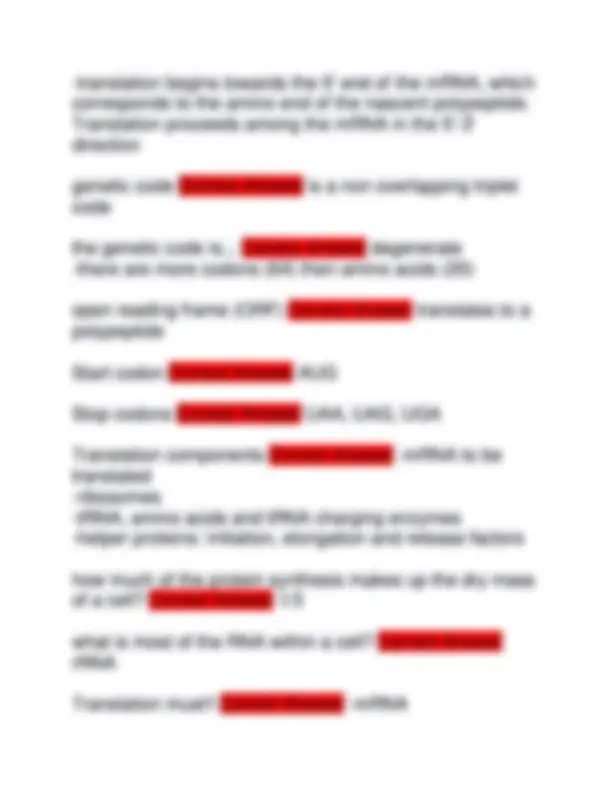
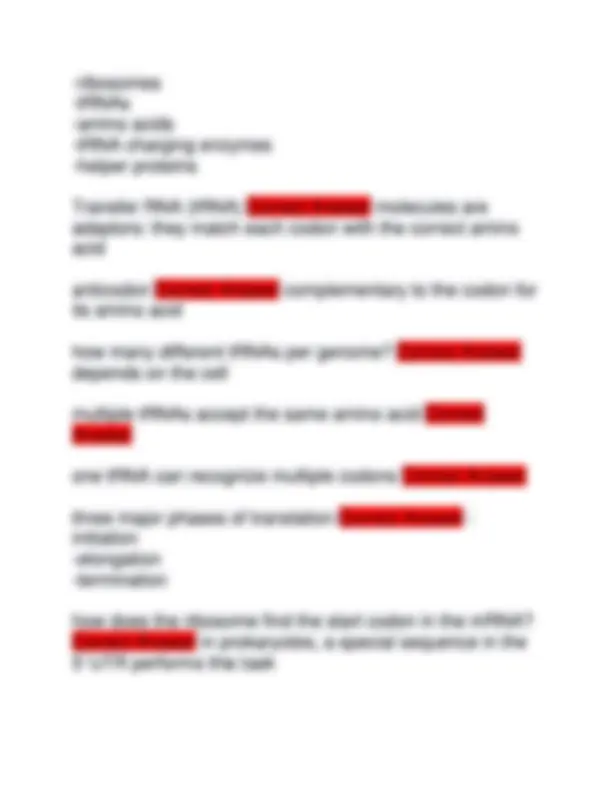
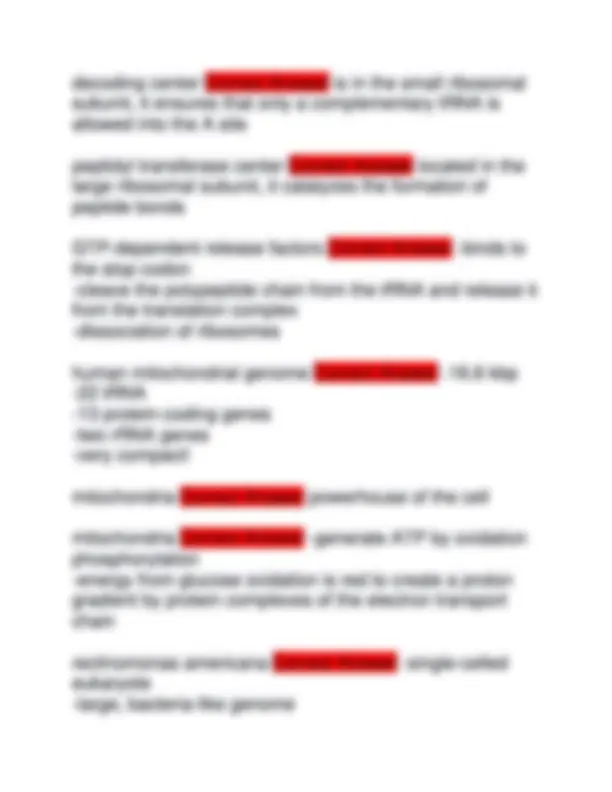
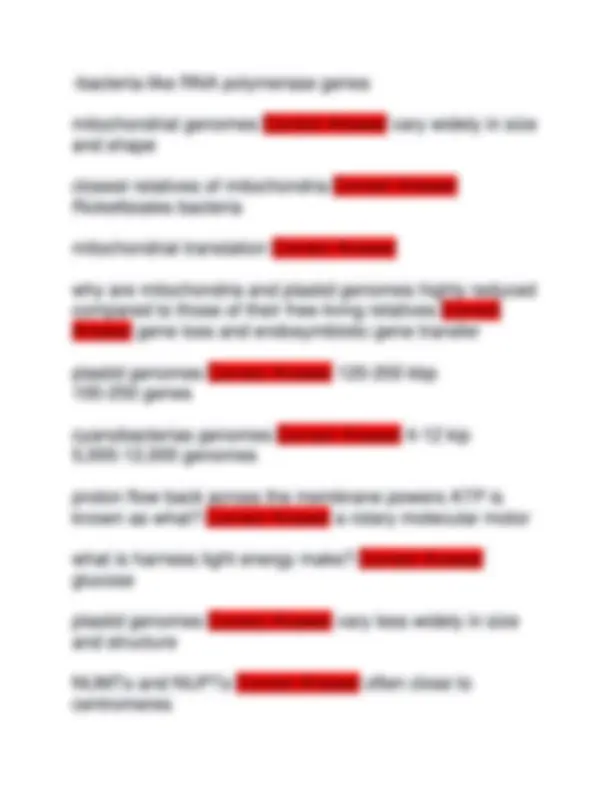
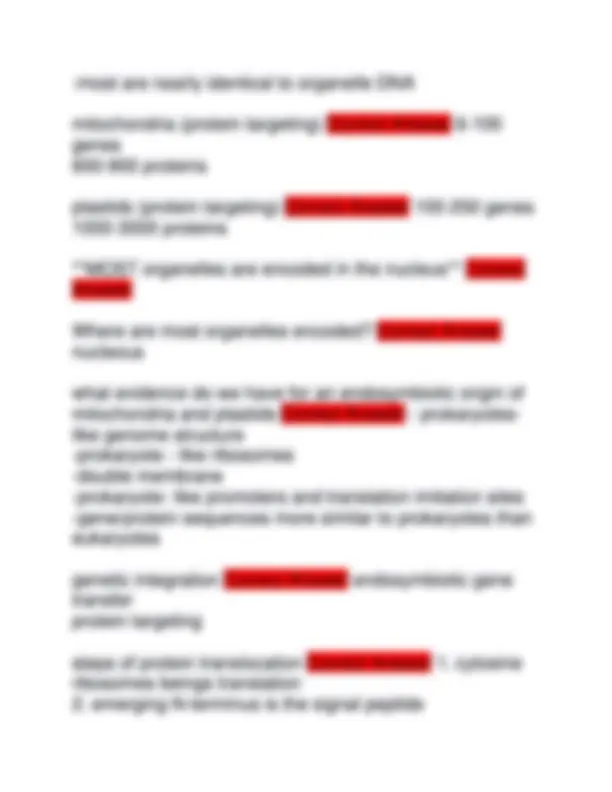
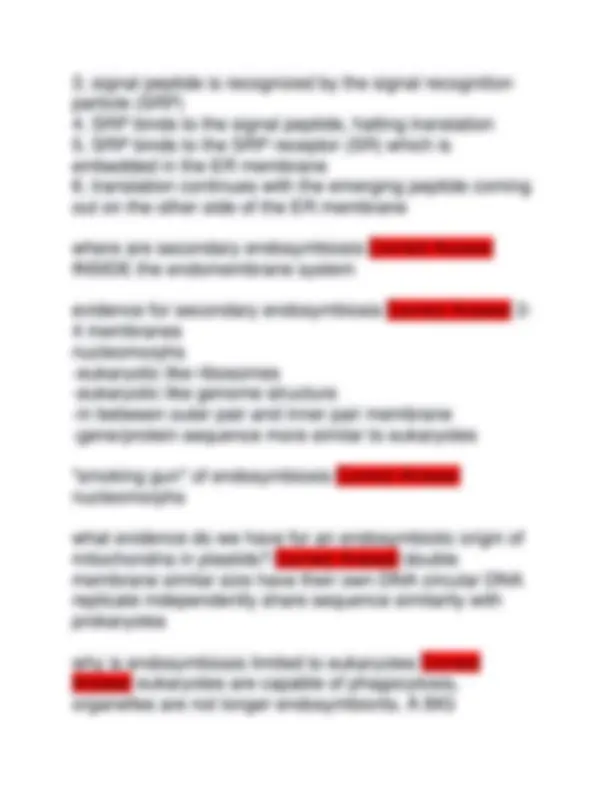
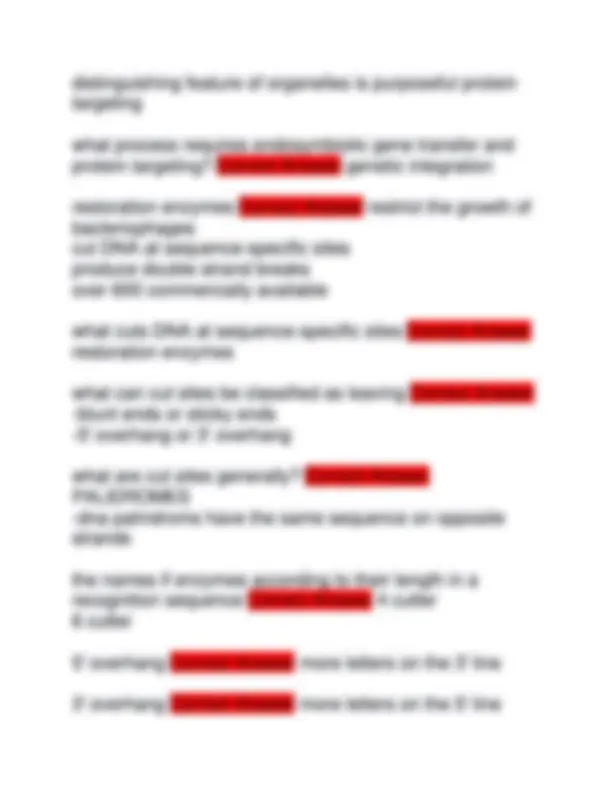
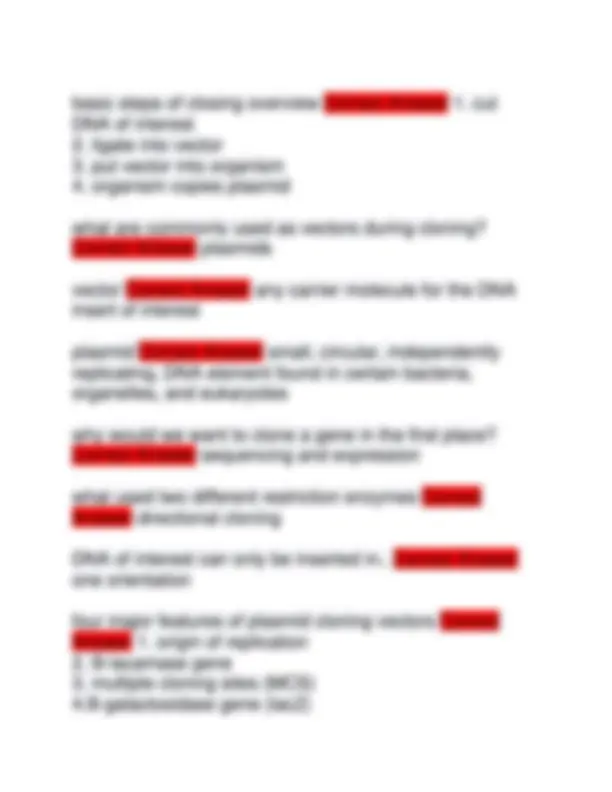
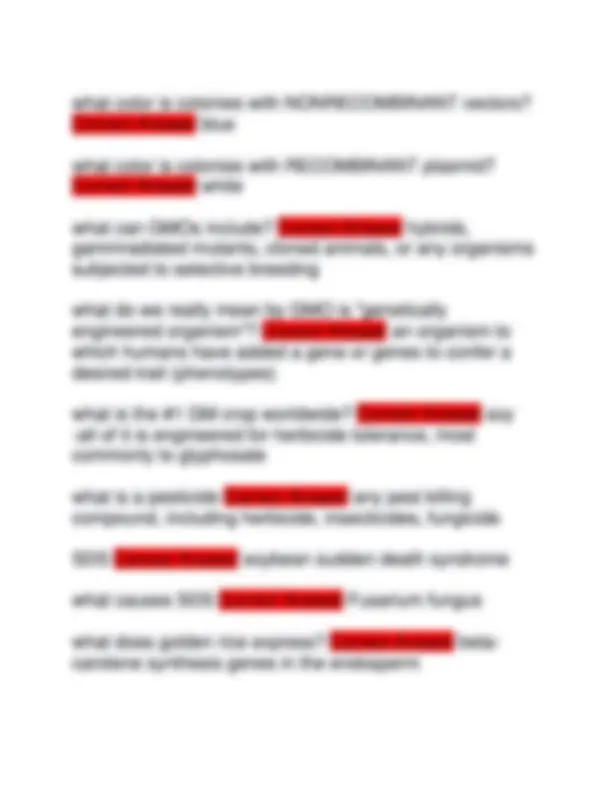
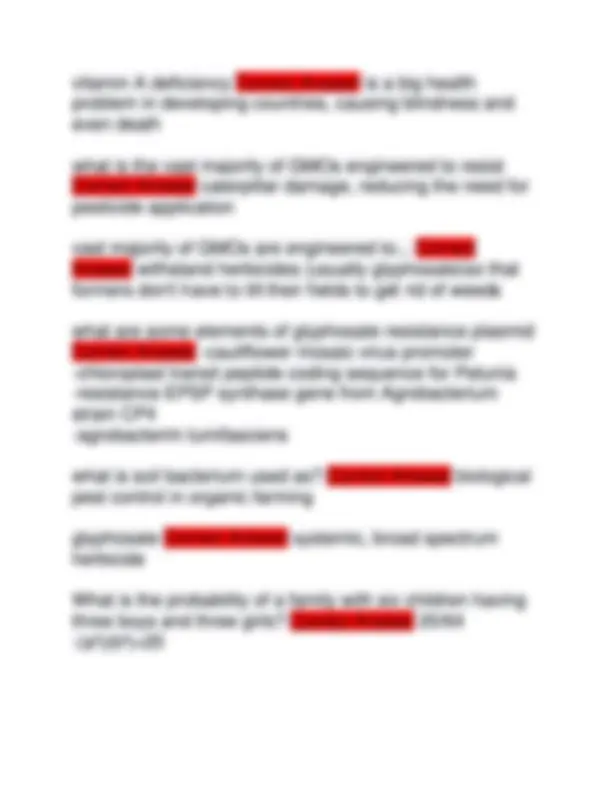
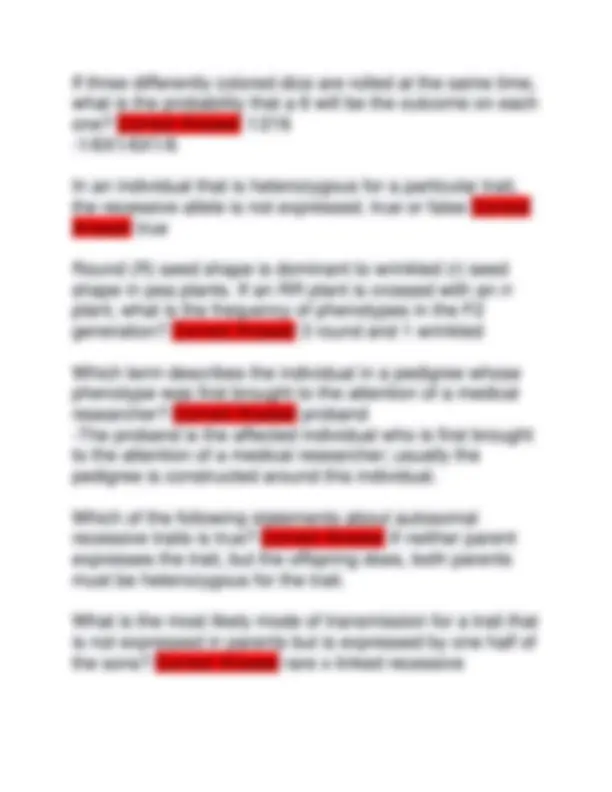
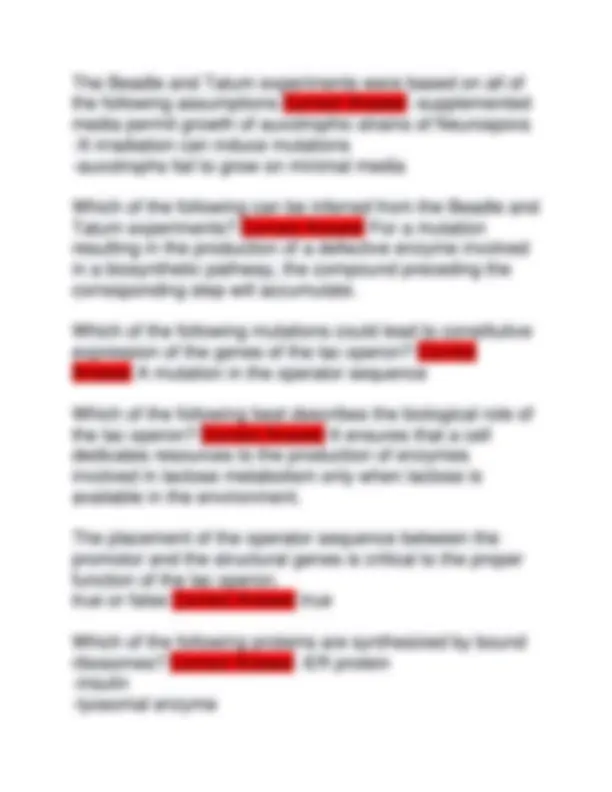
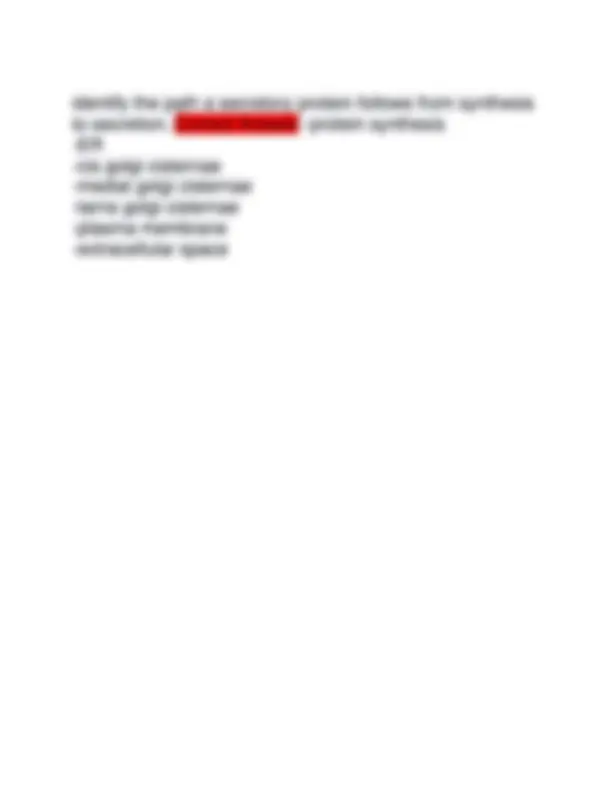


Study with the several resources on Docsity

Earn points by helping other students or get them with a premium plan


Prepare for your exams
Study with the several resources on Docsity

Earn points to download
Earn points by helping other students or get them with a premium plan
Community
Ask the community for help and clear up your study doubts
Discover the best universities in your country according to Docsity users
Free resources
Download our free guides on studying techniques, anxiety management strategies, and thesis advice from Docsity tutors
BIO 340 FINAL EXAM NEWEST 2025 QUESTION BANK 2025 LATEST QUESTIONS AND CORRECT ANSWERS | A+ GRADE
Typology: Exams
1 / 74

This page cannot be seen from the preview
Don't miss anything!



































































You are screening a population of 350 island sheep for coat color, and you count 100 black sheep and 250 white sheep. What is p, frequency of the "black" allele of the TYRP1 gene? Crossing true breeding black sheep with true breeding white sheep always results in 100% black sheep. Correct Answer p= 0. In the same population, if it is under Hardy-Weinberg equilibrium, howe many individuals do you expect to be heterozygous at TYRP1? Correct Answer 92 You come back after the population has gone through one generation, and count 445 white sheep and 208 black sheep. What is the EXPECTED number of heterozygotes in the new generation, if this population is in hardy- weinberg equilibrium? Correct Answer 171 What is the OBSERVED number of heterozygotes in the new generation? Correct Answer 188 Using the same logic, you get the expected and observed number of homozygotes in the new generation, and run a x^2 test. You find your p-value is 0.8377. What can you say about this population? Correct Answer This population
is in Hardy-Weinberg equilibrium at the TYRP1 locus: the TYRP1 is not experiencing any force of evolution. In which of these populations in Natural Selection more likely to occur? Correct Answer A large population with high phenotypic variation In eukaryotes, processing (capping, splicing) is taking place at the 5' end while the 3' end is still being synthesized. In prokaryotes, which is taking place while RNA is being synthesized? Correct Answer Translation beginning at the 5' end while the 3' end is being synthesized What would be the effect of a drug that altered the structure of allolactose so that it was unable to bind to the regulator protein? Correct Answer The drug would prevent the individual from digesting lactose All of the following are true of a single peptide EXCEPT: Correct Answer Signal peptides determine when a protein is exposed True about a single peptide Correct Answer signal peptides determine where a protein should be transported signal peptides can be combined a signal peptide is removed after it serves its function SRPs bind to the signal peptide An adaptive allele A arises in a population such that AA individuals leave 10% more offspring AA+ individuals
by Mendel that distinguished his experiments from those of his contemporaries? Correct Answer Mendel performed controlled crosses with pure-breeding strains. Many of Mendel's experiments involved crosses in which the sexes of the pure-breeding parents were switched. In each case he observed an F1 with the same phenotype. These pairs of experimental crosses are known as _______. Correct Answer reciprocal crosses Mendel's law of segregation predicts the following specific phenotypic ratios among the F1 and F2 progeny from crosses between two pure-breeding parents for a single trait (e.g., yellow vs. green peas). Correct Answer F1 1: F2 3: Based on the law of segregation, what proportion of the F plants would be expected to produce F3 progeny phenotypes in a ratio of 3 dominant : 1 recessive? Correct Answer 1/ Based on Mendel's law of independent assortment, what phenotypic ratios are expected among the F2 progeny from a dihybrid cross such as the one illustrated in figure above? Correct Answer 9:3:3: How many different combinations of alleles are possible among the gametes produced by an individual that is heterozygous for three separate genes? Correct Answer Eight
In pedigree analysis, which of the following is a hallmark of an autosomal recessive disorder? Correct Answer Individuals who have the disease are commonly born to normal (unaffected) parents. The field of genetics has demonstrated that both molecular and transmission genetics characterize the same hereditary processes at different levels. For example, the wrinkled seed phenotype used by Mendel results from a defect in the gene that encodes which of the following products? Correct Answer starch-branching enzyme In the early 1900s, scientists noted that chromosome movements during cell division in reproductive cells mirrored the patterns of inheritance described by Mendel. These results and others confirmed that Mendel's hereditary units (genes) were located on chromosomes. The sum total of chromosomes in an organism constitute its __________, whereas the organism's observable traits constitute its __________. Correct Answer genotype; phenotype Which domain(s) of life include(s) multicellular organisms? Correct Answer Eukarya Watson and Crick derived their model of DNA structure not from their own laboratory research but rather through the analysis and interpretation of experimental data generated by others, such as Erwin Chargaff, Rosalind Franklin, and Maurice Wilkins. Which of the following
Consider a recessive mutation that results in a complete loss of gene function. If heterozygous individuals (mutant/wild-type) are phenotypically wild-type, then the wild-type allele would be described as being __________ Correct Answer haplosufficient What types of mutants commonly result from regulatory mutations that increase the rate of transcription of a gene? Correct Answer Hypermorphi If two alleles of a gene (T1 & T2) are incompletely dominant, then selfing individuals that are heterozygous for these two alleles will produce what phenotypic ratios among the progeny? Correct Answer 1:2: The H antigen that directs the formation of ABO blood groups in humans depends on the activity of the final enzyme product of the H gene. Which of the following best describes the type of molecule on the surface of red blood cells that is responsible for the determination of ABO blood type? Correct Answer glycolipid In 1905, Lucien Cuenot observed that crosses between two yellow mice consistently produced progeny ratios of two yellow : one agouti (wild-type). What is the explanation for the observed 2:1 phenotype ratio? Correct Answer The yellow allele is a recessive lethal. What is the name given to the phenomenon in which some individuals with a particular genotype fail to display the
corresponding phenotype? Correct Answer Incomplete penetrance What is meant by variable expressivity in genetics? Correct Answer A single genotype produces a range of phenotypes that differ in the degree or magnitude of expression of the particular trait specified by the gene. In complementary gene interactions, two genes work in tandem to produce a particular phenotype. Functional copies of both genes are required to produce the phenotype. What phenotypic ratios would be expected among the F2 progeny of a dihybrid cross involving dominant and recessive alleles for two such complementary genes? Correct Answer 9: In genetic complementation testing, crosses are performed between pure-breeding strains for recessive mutations that confer the same mutant phenotype. If the two mutations are in different genes, then what phenotypic ratios would be expected among the progeny? Correct Answer All of the F1 progeny would be wild-type. Who discovered the structure of DNA Correct Answer Watson and Crick Double-stranded DNA can be denatured into single- stranded DNA by heating, which breaking hydrogen bonds. What nucleotide content would describe a species that melts at a significantly higher temperature? Correct Answer One in which there is a greater number of C-G
proteobacteria and cyanobacteria, respectively? Correct Answer the sequence of the genes Organisms have been created by nuclear transfer cloning, in which a diploid nucleus from a somatic cell of an adult animal is injected into an enucleated egg cell to create an embryo. Among the many species thus cloned, there has been a prevalence of mitochondrial defects. Which of the following is the most likely explanation? Correct Answer The transferred nucleus may have mutations that alter mitochondrial function Mitochondrial genome transcription, translation, and replication occur where? Correct Answer in the mitochondrial matrix You have a DNA sequence of 1600 bp. To characterize it, you decide to make a restriction map. Cutting with the first enzyme, you show by electrophoresis that the fragments produced are 400 and 1200 bp, respectively. After using the second enzyme, you recover 700-bp and 900-bp fragments. After treatment with both enzymes, fragments were 300, 400, and 900 bp. Which is the correct map? Correct Answer - 400 - /300-/--- 900 ----- In selecting recombinant bacteria, cells are chosen that are resistant to a specific antibiotic. How are the bacteria made resistant? Correct Answer The antibiotic resistance gene is encoded in the vector.
Which of the following is a possible advantage for the environment of having farmers use plants that genetically produce Bt toxin? Correct Answer Plants with genes for the toxin are eaten less often by insects, and therefore less insecticide is needed. In using Agrobacterium tumefaciens to transfer genes into plants, what is transferred from bacterium to plant? Correct Answer T-DNA If a researcher is cloning a sequence by using pUC and uses the plasmid to transform bacteria, which are then plated on X-gal medium, would the recombinant plasmids be found in blue or white colonies or both? Correct Answer white Which type of DNA library (genomic or cDNA) would include introns and promoters? Correct Answer genomic X-Gal is included in the growth medium on which cells transformed with bacterial plasmids are grown. The reason X-Gal is included is to _______. Correct Answer identify bacteria that contain a recombinant plasmid Within a six-base DNA recognition sequence, an enzyme that cuts between the 3rd and 4th bases from the 5' end will generate blunt ends. Correct Answer true Which of the following would be required in a bacterial expression vector but NOT in a bacterial cloning vector? Correct Answer bacterial promoter
In bulbbasaurs, seed color is controlled by a single gene with three alleles. How many different diploid genotypes are possible in this gene? Correct Answer Six (3 x 2 = 6) A man and woman both have brown hair and are carriers of the recessive allele for red hair. They plan on having 4 children. What is the probability they have 3 boys and 1 girl? What is the probability they have 3 boys and 1 girl, and that girl has red hair? Correct Answer P(3 boys & 1 girl) = [(1/2)(1/2)(1/2)(1/2)] + [(1/2)(1/2)(1/2)(1/2)] + [(1/2)(1/2)(1/2)(1/2)] + [(1/2)(1/2)(1/2)(1/2)] = 1/ The probability of having a boy or girl is 1/ There are four different combinations to have 3 boys and 1 girl (BBBG, BBGB, BGBB, GBBB) P(3 boys & 1 girl w/ red hair) = [(1/2)(1/2)(1/2)(1/8)] + [(1/2)(1/2)(1/8)(1/2)] + [(1/2)(1/8)(1/2)(1/2)] + [(1/8)(1/2)(1/2)(1/2) = 1/ The probability of having a girl (1/2) and red hair (1/4) is 1/8 because (1/2)(1/4) = 1/ In sea bass, the appearance of lateral stripes and red eyes are produced by the dominant alleles L and R, respectively, which are found at 2 independently assorting loci. At these loci, the genotype ll produces lateral spots and the genotype rr produces yellow eye color. To determine the genotype of a lateral-striped, red-eyed male, a test cross is performed. The offspring are 115
striped, red-eyed; 121 striped, yellow-eyed; 130 spotted, red-eyed; 120 spotted, yellow-eyed. What is the most likely genotype of the father? Correct Answer The father is heterozygous for both genes In the biosynthetic pathway for conversion from homoserine to methionine, you identify a double mutant Met1/Met2. This mutant will grow only if which supplement(s) are added to minimal media? Correct Answer Methionine only You have 2 true-breeding strains of lucky cat in your lab. The W strain has white fur and the G strain has golden fur. You cross W and G strains. The F1 from this cross have golden fur. When you cross 2 F1's, the F2's have either golden or white fur. In the F2's, the ratio of golden to white is 9:1. Develop a hypothesis to explain this ratio. Correct Answer Recessive lethal The allele can be both dominant (that's why the F generation all has golden fur) AND recessive lethal (that's why the F2 generation has both white and golden fur in a 9:1 ratio) The O locus in domesticated cats is X-linked. The big O allele produces orange coloration and the little o allele produces black coloration. Males are hemizygous for the locus and females are mosaics; therefore, the dominance relationship between the alleles cannot be determined by crossing experiments. Describe a possible research
Ab/ab = .45 x .05 = 0. Ab/Ab = .45 x .45 = 0. aB/aB = .45 x .45 = 0. aB/Ab = .45 x .45 = 0. aB/AB = .45 x .05 = 0. aB/ab = .45 x .05 = 0. AB/AB = .05 x .05 = 0. AB/Ab = .05 x .45 = 0. AB/aB = .05 x .45 = 0. AB/ab = .05 x .05 = 0. ab/ab = .05 x .05 = 0. ab/Ab = .05 x .45 = 0. ab/aB = .05 x .45 = 0. ab/AB = .05 x .05 = 0. Grown Stem, Small Seed (A-B-) = 0. Non-grown Stem, Big Seed (aabb) = 0. Grown Stem, Big Seed (A-bb) = 0. Non-grown Stem, Small Seed (aaB-) = 0. Titin (T) is the largest gene in the cattle genome. Your herd contains 3 deleterious mutations: T1 is dominant and located at 1 cM from the start of the gene. T2 is recessive and located at 3 cM from the start. T3 is also recessive and located 5 cM from the start. Your bull carries both recessive and mutations on separate chromosomes, while your cow is heterozygous for the dominant mutation. What is the probability that when mated they produce an offspring that is not a carrier for any of the mutations. Correct Answer (0.5)(0.5)(0.02) = 0.
0.5 chance of getting fully functional allele (+++) from mom, 0.5 chance of getting ++- from dad, and 2% chance crossover. 0.05 - 0.03 = 0.02 (how far apart they are from each other) Bull: ++(T3)/+(T2)+ Cow: +++/(T1)++ A troop of Japanese snow monkeys have become a nuisance in their native, wintery range. As part of an experiment, they have been relocated to Apache Junction, AZ. Within the troop, there are phenotypic differences for both fur length and fur density, but there are no genetic differences for these traits. Would you expect the monkey troop to evolve in response to their new environment, with respect of these phenotypes? Why or why not? Correct Answer No, because there is no genetic basis. Therefore, traits would not be passed down. Parent-child and full-sibling kinship coefficients are both 25%. By looking at the patterns of IBD in their genomes, how can you distinguish the relationships? Correct Answer Parent-child will have an entire chromosome in common, while only full siblings have parts of chromosomes in common. Many plants exhibit a mating system known as mixed- mating. A certain fraction (s) of seeds are produced by selfing and the rest (1-s) by outcrossing. Assuming that a plant population is not currently inbred, after one
What is the probability of fixation of a novel wg mutation that arises in a colony of 50 British coastal flies with stable population size? Correct Answer The probability of fixation is 1/2N 1/2N = 1/2(50) = 0.01 = 1% Probability Correct Answer the frequency of that event among all possible events exp. tossing a coin Joint Probability Correct Answer the probability that two events occur together Additive Rule of Probability Correct Answer if two events, A and B, are mutually exclusive, then the probability that either one occurs is the sum of their individual probabilities Multiplicative Rule of Probability Correct Answer If two events are independent, then their joint probability is given by: P(A and B)= P(A) x P(B) Your bike has a flat tire with the probability 1/10. Your car has a flat tire with a probability 1/100. Your care and bike both have flat tires with probability 1/110. Are these events independent? Correct Answer False Mendel's five critical Experimental Innovations Correct Answer 1. controlled crosses between plants